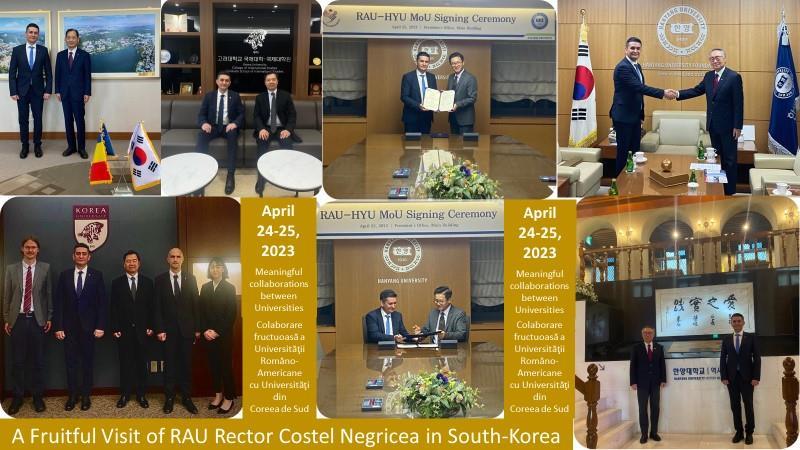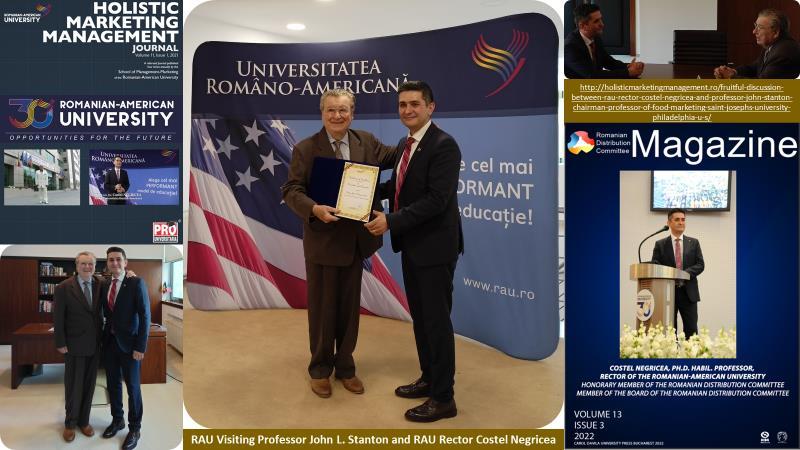
Editorial Board of “Holistic Marketing Management”
(A refereed journal published four times annually by the School of Management-Marketing of the Romanian-American University)
Editor-in-Chief
Theodor Valentin PURCĂREA
Bernd HALLIER
President of European Retail Academy; President of EuCVoT; Member of the Astana Economic Scientists Club; Former Managing Director EHI Retail Institute, Germany, Chairman of the Advisory Board of EuroShop, Chairman of the Board of the Orgainvent, Trustee of EHI Retail Institute at GLOBALG.A.P.
John SAEE
John L. STANTON
President - Association of Global Management Studies (USA); Editor-in-Chief, JournalofEntrepreneurshipandSustainabilityIssues &FormerEditor-in-Chief, Journal of Management Systems, USA; Australian Graduate School of Entrepreneurship, the Facultyof Business and Enterprise, Swinburne University of Technology; Member of France’s National Academy of Scientific Research (CNRS); Director - ESB International Teaching and Research Exchanges, Reutlingen University, Germany
Professor of Food Marketing, Erivan K. Haub School of Business, Saint Joseph’s University Philadelphia, USA; Director, Institute of Food Products Marketing, Editor, Journal of Food Products Marketing; Hall of Fame of the European Retail Academy, Honored Personality 2016
Léon F. WEGNEZ
William PERTTULA
Levent ALTINAY
Secretary General, International Association of the Distributive Trade, AIDA Brussels; Member of France’s Academy of Commercial Sciences; Doctor Honoris Causa of NUPSPA (SNSPA) Bucharest; Hall of Fame of the European Retail Academy, Honored Personality 2015; Administrator Secretary General of the Diplomatic Club of Belgium
Internet Marketing Professor, College of Business, San Francisco State University, USA
Professor of Strategy and Entrepreneurship, Research Area Leader, Oxford School of Hospitality Management, Faculty of Business, Oxford Brookes University, UK
Andrew KILNER
First MBA Director at the Rennes Graduate School of Business in France; Director of RAFME Research into Management Excellence; PhD (Cambridge), MBA (City, London)
Dana ZADRAZILOVA Faculty of International Economic Relations, University of Economics, Prague, Czech Republic
Riccardo BELTRAMO University of Turin, Italy
Sinisa ZARIC University of Belgrade, Yugoslavia
Gabriela SABĂU Memorial University, Grenfell Campus, Corner Brook, Canada
Hélène NIKOLOPOULOU University of Lille 3, France
Vasa LÁSZLÓ Szent Istvan University, Hungary
Peter STARCHON Comenius University in Bratislava, Slovakia
John MURRAY Faculty of Business, Dublin Institute of Technology, Ireland
Holistic Marketing Management 1
Kamil PÍCHA Faculty of Economics, University of South Bohemia in Ceske Budejovice
Irena JINDRICHOVSKA Deputy Head of Department of Business Economics, University of Economics and Management, Prague, Czech Republic
Norbert HAYDAM Faculty of Business, Marketing Department, Cape Peninsula University of Technology, South Africa
Hans ZWAGA Kemi-Tornio University of Applied Sciences, Finland
Roxana CODITA Technische Universität München, TUM School of Management
Valeriu IOAN-FRANC
Corresponding Member of the Romanian Academy, General Deputy Director, National Institute for Economic Research “Costin C. Kiriţescu”, Romanian Marketing Association; Romanian Distribution Committee
Dumitru MIRON Academy of Economic Studies in Bucharest, President of RAFPEC (FRAPEC)
Iacob CĂTOIU Academy of Economic Studies in Bucharest
Virgil BALAURE Academy of Economic Studies in Bucharest
Gheorghe ORZAN Academy of Economic Studies in Bucharest
Luigi DUMITRESCU Lucian Blaga University of Sibiu
Marius D. POP Babes-Bolyai University, Cluj-Napoca
Constantin ROŞCA President of Romanian Scientific Society of Management - SSMAR
Petru FILIP Dimitrie Cantemir University, Bucharest
Ion VOICU SUCALA
Technical University of Cluj-Napoca, Management and Economic Engineering Department; University of Glasgow, UK, College of Social Sciences, School of Social & Political Sciences; Managing Editor, Review of Management and Economic Engineering
Virgil POPA Valahia University of Târgovişte
Alexandru NEDELEA Ştefan cel Mare University of Suceava
Olguța Anca ORZAN Carol Davila University of Medicine and Pharmacy Bucharest
Ana-Maria PREDA
Ovidiu FOLCUȚ
Doinița CIOCÎRLAN
Costel NEGRICEA
Tudor EDU
Alexandru IONESCU
Andreea Elisabeta BUDACIA
Marius Dan DALOTĂ
Mihai PAPUC
Gheorghe ILIESCU
Oana PREDA
Olga POTECEA
Nicoleta DUMITRU
Monica Paula RAȚIU
Alexandra PERJU-MITRAN
Romanian-American University
Romanian-American University
Romanian-American University
Romanian-American University
Romanian-American University
Romanian-American University
Romanian-American University
Romanian-American University
Romanian-American University
Romanian-American University
Romanian-American University
Romanian-American University
Romanian-American University
Romanian-American University
Romanian-American University
Associate Editors
Dan SMEDESCU
Irina PURCĂREA
Art Designer Director
Alexandru BEJAN
Holistic Marketing Management 2



Holistic Marketing Management 3 “Holistic Marketing Management” (A refereed journal published four times annually by the School of Management-Marketing of the Romanian-American University) Volume 13, Issue 3, Year 2023 Contents Theodor PURCĂREA - Rewriting the Rules, 17 Years from the Launch of RAU Marketing Initiative Regarding New Skill Sets.....................4 Dominic Elena MAGNO - The Influence of Social Media on Contemporary Consumer and Tudor EDU Behavior: Part I, Introduction and Literature Review..................11 Ioan Matei PURCĂREA - E-Commerce, E-Fulfillment, Last Mile Delivery and CX..........................................................................................37 Dan SMEDESCU - ‘Marketing Science and Inspirations’: Making Decisions Based on Social Media Metrics Tracked by Marketers 47 HMM Personalia Corner ● RAU Engagement in Bridging and Broadening Perspectives – Promoting Romania’s Brand Through University Study Programs...........................53 The responsibility for the contents of the scientific and the authenticity of the published materials and opinions expressed rests with the author.
be effective after changes that may happen in the future, as shown in figure below (Turner, 2023). As the main reasons for making changes to CMOs’ organizational structures (which should follow strategy) were identified (Gartner, 2023) prioritization, workflows and collaboration (and other operational excellence issues), being imperative for CMOs to make a compromise depending on specific things (such as restructuring objectives, capability gaps and cultural realities).



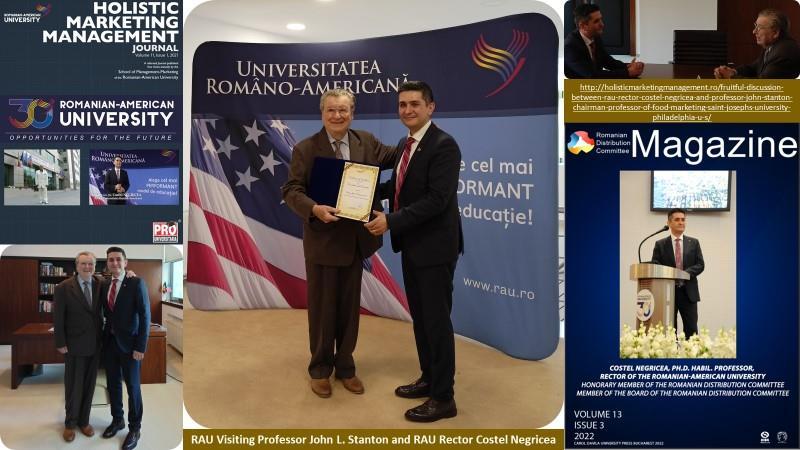



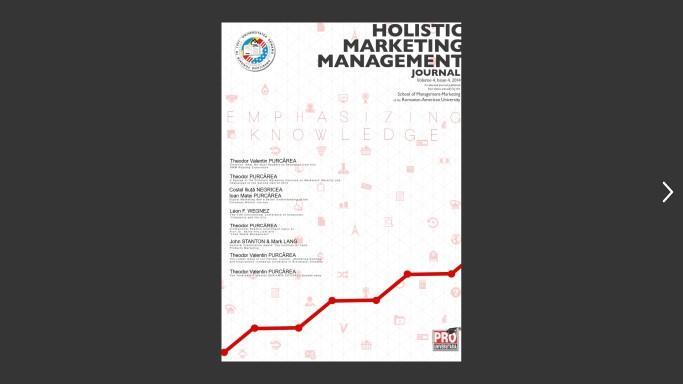
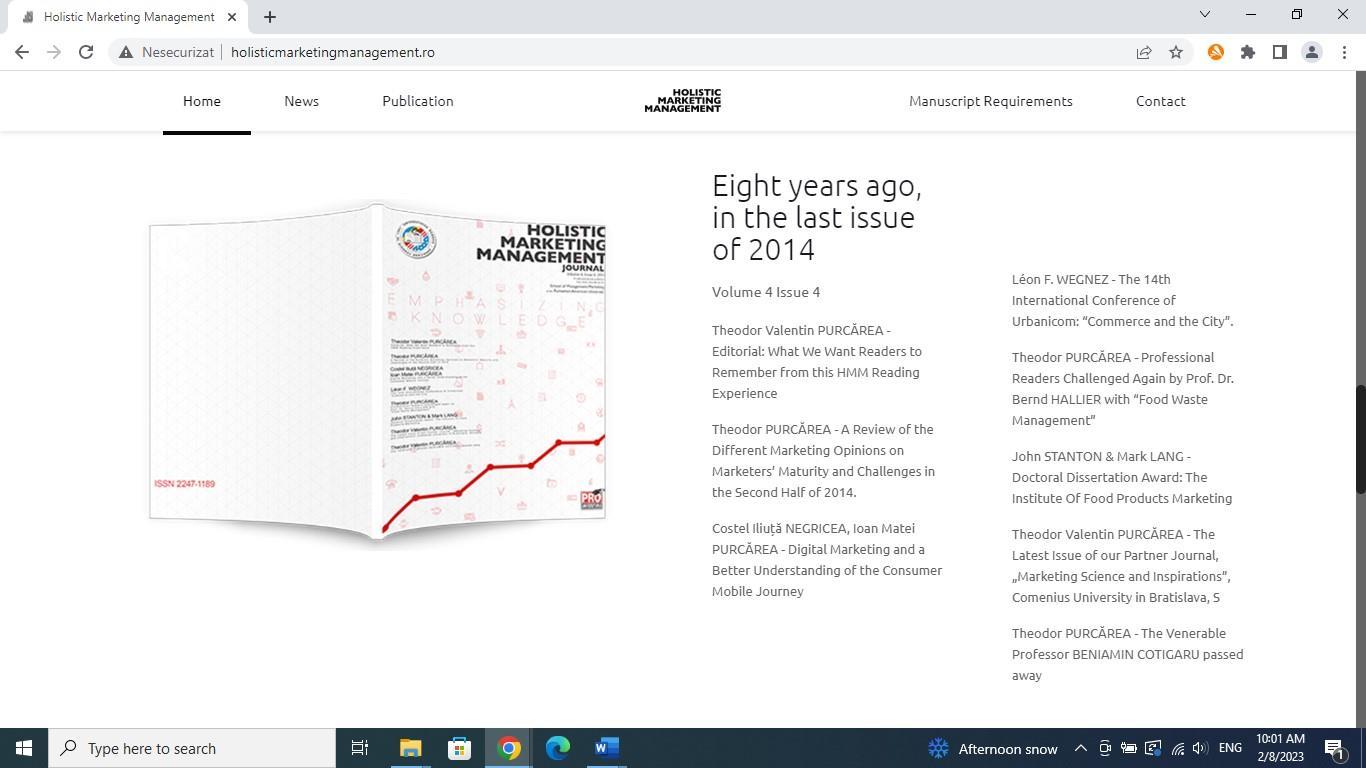

Holistic Marketing Management 4
Source: Turner, J., 2023. How to Future-Proof Your Marketing Organization, Gartner, July 27, 2023 (Work cited)
Within the context of both external, and internal environments impacted by disruption in the recent past Gartner analyzed the impact of the consequential shifting roles and relationships on the so-called RACI matrix for marketing capabilities (which are vital to the delivery of the marketing strategy), and revealed how in strategic areas marketing’s sole responsibilities were increased by CMOs, as shown in the below figure. Gartner is bringing to our attention some significant aspects, such as: in order to support the increased complexity of the customer journeys new skill sets are required, consequently being necessary for CMOs to successfully deal with and control the amplified talent challenge; marketing must be transformed into “an agile, strategic partner for business growth and innovation”, gaining “control over cross-functional dependencies” which impact its success, demonstrating its value continuously combining nearterm with longer-term actions.
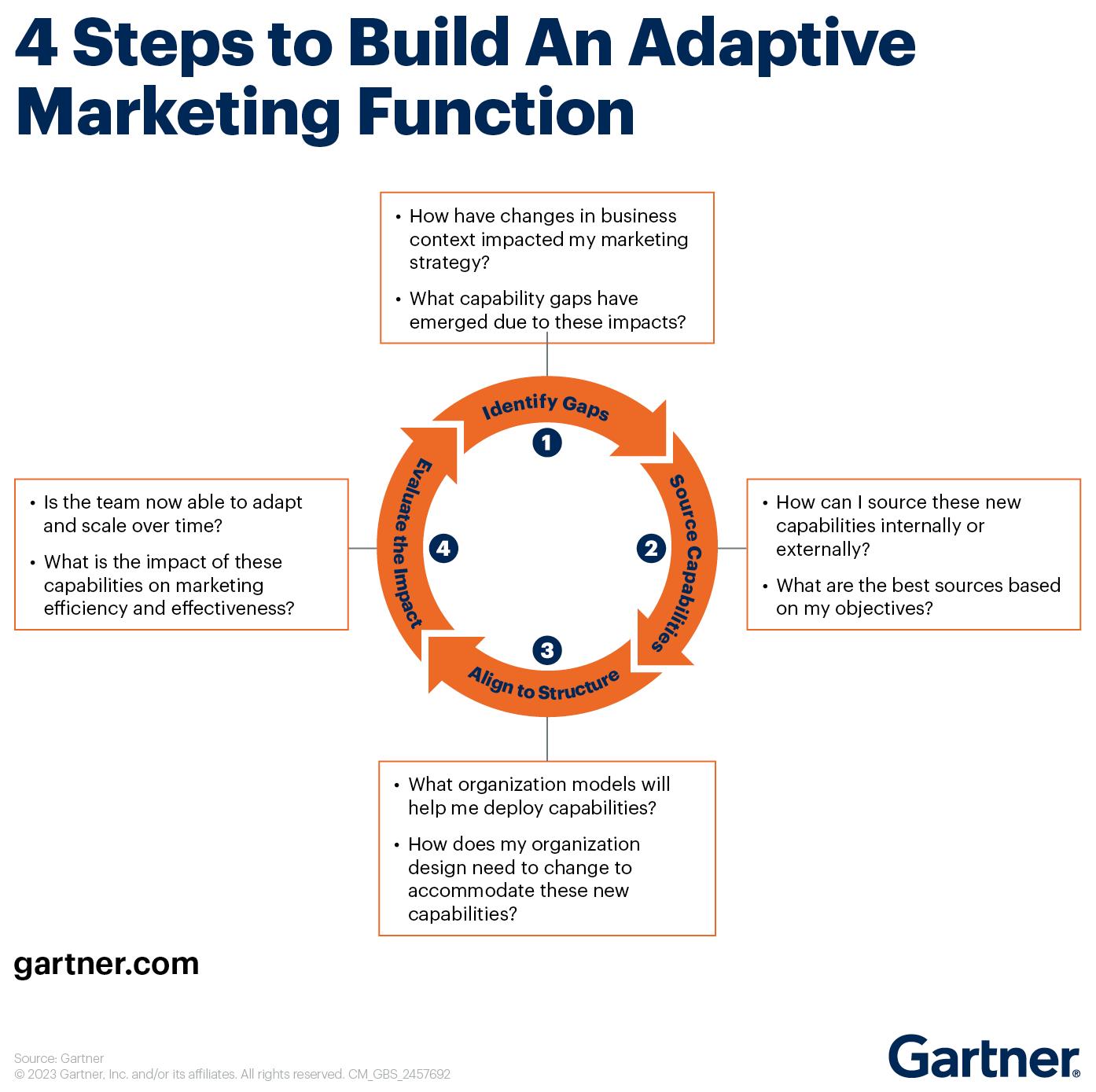
Holistic Marketing Management 5
Figure no. 1: 4 steps to build an adaptive marketing function
Source: Gartner, 2023. Future-Proof Your Marketing Organization to Outpace Competition. [pdf] Build the right foundation to support sustainable growth, Gartner for Marketing Leaders, p. 5 (Work cited)

In February this year we wrote about marketers’ new tool ChatGPT, including by making reference to Gartner (Purcarea b, 2023) It is useful to add that on October 7, 2022 Gartner published a valuable report (Gartner 2022) in which was analyzed how marketing functions (such as content production, ideation, market research) are impacted by ChatGPT, being imperative for CMOs both to assess the impact of this new tool on creation, branding and operations, and to assemble an active use cases’ list impacted by this new tool, also ensuring the necessary guidance in responsibly use of this new tool (including by considering various for marketing teams’ additional cautions) based on collaborative learning.
According to Downer (2023), in order to leverage effectively the potential this marketers’ new tool ChatGPT it is necessary to consider (beyond its benefits like expert-level marketing support, fresh ideas and perspectives, high-quality content faster, automation of tedious tasks, increased innovation and productivity) and manage its limitations and risks (such as evolving legal and ethical landscape, potential for mediocre content, need for human oversight). Within this framework it was recommended to proceed with both caution, and responsibility, while embracing the above-mentioned potential, by mixing AI’s efficiency and capabilities with human creativity and supervision.
In an article published very recently on Visual Capitalist (Belan, 2023) it was shown how “AI has surpassed human performance in quite a few areas, and looks set to overtake humans elsewhere” (citing recent sources, see figure below), and “how quickly AI models have started to beat database benchmarks, as well as whether or not they’ve yet reached human levels of skill” (visualization based on data from Contextual AI) And as highlighted also very recently in World
Holistic Marketing Management 6
Figure no. 2: CMOs Increased Marketing’s Sole Responsibilities in Strategic Areas
Financial Review (Sridharan, 2023) “AI introduces novel challenges (for AI leadership) such as ethical considerations, human-machine collaboration, and the need for continuous learning. Thus, leaders need a broader set of competencies and perspectives to effectively embrace AIdriven transformation. ”
Source: Belan, M., 2023. AI vs. Humans: Which Performs Certain Skills Better? Visual Capitalist, August 25, 2023 (Work cited)

Holistic Marketing Management 7
Figure no. 3: AI is outpacing human performance
On the other hand, according to Robert Rose the co-author of the book “Killing Marketing” (https://killingmarketing.com/ ), considered the “book that rewrites the rules of marketing” – Rose being the Founder and Chief Strategy Officer of The Content Advisory (which is the education and consulting group for The Content Marketing Institute) – now it’s the real time to find an accurate answer to the following question: “Will AI make your marketing and content stronger or cover for weaknesses?” From his point of view: “The long prevailing theory in business says teams achieve more success by building on their strengths rather than repairing their weaknesses… It suggests you invest in your talents and minimize the effect of your shortcomings. But here’s the challenge. Generative AI in content and marketing is so new, disruptive, and chaotic that few people and even fewer marketing teams can truly point to it as a differentiating strength” (Rose, 2023).
Figure no. 3: Generative AI applications that are most relevant to their business according to executives worldwide, April 2023
Source: Lebow, S., 2023. Marketing uses for generative AI that will outlive the hype, Insider Intelligence, originally featured in the eMarketer Daily newsletter, Jul 28, 2023 (Work cited)
Allow us to end by making reference to the challenging Capgemini Research Institute report from July 2023 and entitled: “Harnessing the value of generative AI. Top use cases across industries”. Based on this report Insider Intelligence brought to our attention some suggestive examples with regard to the most relevant generative AI applications for business, and how marketers can use those applications, as shown in the above figure (Lebow, 2023). The abovementioned July 2023 report (see figure below) highlighted that: “Generative AI has the potential to be a transformative force across all aspects of the value chain, as well as for customer and employee interactions” .
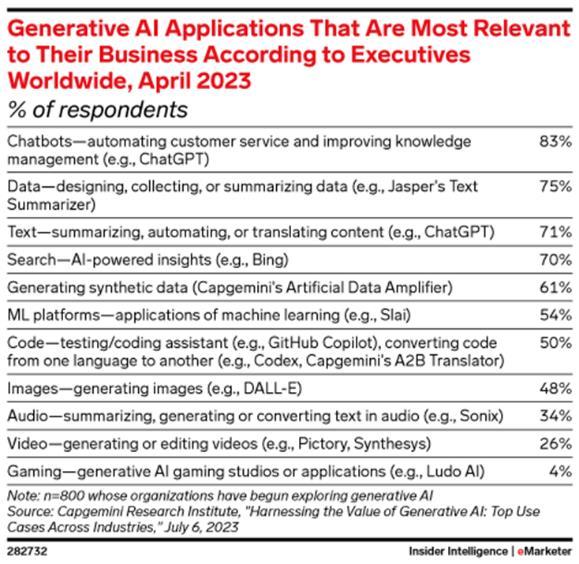
Holistic Marketing Management 8
Figure no. 4: The power of generative AI unleashed across the value chain
Source: Capgemini, 2023. Harnessing the value of generative AI: Top use cases across industries. [pdf] July 2023, p. 43 (Work cited)
So, let us valorize collaborative learning, developing critical thinking that is coming forth from a value position and help us to make better judgements based on evidence and reasoning, drawing conclusions accordingly!
Theodor Valentin Purcărea
Editor-in-Chief
References
Belan, M., 2023. AI vs. Humans: Which Performs Certain Skills Better? Visual Capitalist, August 25, 2023. Available at: <https://www.visualcapitalist.com/ai-vs-humans-which-performs-certain-skills-better/> [Accessed 30 August 2023].
Capgemini, 2023. Harnessing the value of generative AI: Top use cases across industries. [pdf] July 2023, p. 43. Available at: <https://prod.ucwe.capgemini.com/wp-content/uploads/2023/07/Final-Web-Version-ReportHarnessing-the-Value-of-Gen-AI.1.pdf> [29 August 2023].

Downer, K., 2023. Risks vs Rewards of ChatGPT For Marketing, DowSocial, August 2, 2023. Available at: <https://www.dowsocial.com/risks-vs-rewards-chatgpt-marketing/> [Accessed 15 August 2023].
Gartner, 2023. Future-Proof Your Marketing Organization to Outpace Competition. [pdf] Build the right foundation to support sustainable growth, Gartner for Marketing Leaders, pp. 4-7. Available at: <future-proof-marketingorganization-to-outpace-competition-ebook> [Accessed 17 August 2023].
Gartner, 2022. Quick Answer: How Should CMOs Respond to ChatGPT Today? [pdf] Gartner for Marketing Leaders, pp. 2-11, 7 October 2022. Available at: <quick_answer_how_should_cmos_respond_to_chatgpt_today_may> [Accessed 4 May 2023].
Lebow, S., 2023. Marketing uses for generative AI that will outlive the hype, Insider Intelligence, originally featured in the eMarketer Daily newsletter, Jul 28, 2023. Available at: <https://www.insiderintelligence.com/content/marketing-uses-generative-ai-that-will-outlive-hype?> [Accessed 31 July 2023].
Holistic Marketing Management 9
Purcarea, T., 2023. A New Revolution in Marketing and Sales or a Role Redefinition? Holistic Marketing Management, vol. 13(2), pp. 04-08, July.


Purcarea, T. 2023. Disrupted and Reshaped Global Supply Chains, Marketing Performance, and Marketers’ New Tool ChatGPT and Its Competition, Holistic Marketing Management, vol. 13(1), pp. 04-11, February.
Rose, R., 2023. Will AI Make Marketing Teams Stronger or Cover Their Weaknesses? The Content Marketing Institute, August 29, 2023. Available at: <https://contentmarketinginstitute.com/articles/generative-ai-marketingteams-efficient?> [Accessed 30 August 2023].

Sridharan, S., 2023. Future of Human Leadership in the AI age, World Financial Review, August 16, 2023. Available at: <https://worldfinancialreview.com/future-of-human-leadership-in-the-ai-age/> [Accessed 30 August 2023].
Turner, J., 2023. How to Future-Proof Your Marketing Organization, Gartner, July 27, 2023. Available at: <https://www.gartner.com/en/articles/how-to-future-proof-your-marketing-organization?> [Accessed 10 August 2023].

Holistic Marketing Management 10
R 3nd nni ersary
The influence of social media on contemporary consumer behavior: Part I, Introduction and Literature Review
Dominic Elena MAGNO and Tudor EDU
Abstract
The significance of social media in today’s world cannot be understated. It has significantly altered how we connect, communicate, and obtain information. Regardless of distance, online communication has made it simpler for people to stay in touch with friends and family. Today’s society is heavily reliant on social media, with billions of users regularly using sites like Facebook, Instagram, and Twitter. Customers are once again in the forefront in the business world thanks to the widespread usage of social media, which also provides marketers with a brand-new set of tools for connecting with customers and inventively integrating them into businesses. In essence, marketers need to be aware of the impact social media has had on customers' buying behavior. Understanding how social media affects consumer behavior can offer useful insights on consumer tastes, inclinations, and decision-making processes, which can guide marketing initiatives and promote company expansion. Businesses can more effectively communicate with customers, better focus their marketing campaigns, and keep on top of consumer trends by researching the effects of social media. Additionally, companies that comprehend how social media affects consumer behavior are at a competitive edge over rivals. Overall, social media has both positive and negative consequences on society, but it has unquestionably altered how we connect and communicate with one another, and it is sure to continue to develop and have potentially interesting implications on our daily lives. Recognizing that consumer behavior is a fairly comprehensive and broad topic, it would be difficult to gather, examine, and draw all relevant data and findings into single research; consequently, the research has concentrated on how decisions are made as it applies to social media marketing. The study’s goal is to identify the causes, timing, and ways in which social media’s influence on consumer decision-making. Additionally, possibly with this specific perspective, the research can help identify the chances and problems businesses are confronting with this impact on customers’ decisionmaking in order to capture and embrace the opportunities in the new marketing era. Our study used two research questions within this context:
1. How do consumers receive, interpret, and choose the information before making a decision?
2. How social media today affects on consumer behavior? This paper is divided into four chapters, as follows. Part I contains Introduction and Chapter II, the relevant literature review with regard to the consumer decision making process, social media, social media and consumer behavior, and figures about social media. Part II presents the research methodology (qualitative research; research variables connected to the discussion topics). Part III contains research findings and discussion, and Part IV presents the research conclusions.
Keywords: Social media; Consumer behavior; New marketing era
JEL Classification: D10; D80; L81; L82; M31
Chapter II: LITERATURE REVIEW
The way businesses function today has undergone a transformation thanks to the quick development of technology and its accessibility at low cost. Millions of people are currently using the Internet, therefore these technologies have caused a paradigm shift in how communication takes place. The influence of “social media” on brand reputation and market presence is increasing.
Holistic Marketing Management 11
• D. Lakshmanan and Dr. S. Rabiyathul Basariya (2017) conducted research on the efficacy of social networking site advertising. The study finds that the effectiveness of social media marketing is significantly influenced by the caliber of communications or materials, the business's involvement, and its linkages to other marketing platforms. A thorough and indepth analysis of the strategy is also necessary to accurately measure the expected return upon investment of social media marketing.
• In his paper, Sadia Afzal et al. (2015) studied the influence of traditional and internet advertising on customer purchasing behavior for branded clothing. The findings showed that important elements influencing customer purchasing behavior include product quality, design, advertisement content, brand loyalty, and prior purchasing experiences.
• According to Loredana Di Pietro and Eleonora Pantano (2012), social networks are becoming into an effective tool for IT-based business because they offer both consumers and marketers a number of services. The purpose of this study is to determine the extent to which social media sites like Facebook affect consumers' purchasing decisions through a quantitative analysis that incorporates a new model of technology acceptance. The results show that using social networks as a tool to support a purchasing decision is heavily influenced by enjoyment. By offering substantial information on the importance of this channel for the creation of new direct marketing strategies, this research goes beyond social network usage to factors connected to Facebook-mediated marketing communications.
• In a study conducted by Mass Relevance, a company that offers clients a social media curation platform, it was discovered that 64% of the consumers interviewed had already made purchases based on social media presence and reviews and that 59% of social media activity increases a brand's credibility with consumers. According to a study conducted by Edelman (2010) for Harvard Business Review, the Internet and social media have altered not just how businesses run but also how customers chose the things they buy. It explains how buyers no longer choose things with a logical manner as the market has changed to a more open-ended approach. It emphasizes how crucial it is for brands to engage with customers and looks at their purchasing behaviors across three continents and five distinct industries: electronics, automobiles, cosmetics, insurance, and mobile telecoms. Based on the study’s findings, a four-stage model that emphasizes how modern customers use social media to promote businesses and make purchases based on the feedback they receive was presented.
• In their research report from 2016, Chintan H. Rajani and Dr. Ashvin Solanki identify the main driving forces for Indian users' usage of social networking sites. According to the survey, the main reasons people use social media include feedback and personal utility, entertainment and socializing, content sharing, and networking. In order to uncover the primary reasons for utilizing social media described above, this study used the uses and pleasure approach. The results of the study show that before satisfying their requirements for amusement and interaction with others, people first use social networking sites for their own benefit in order to evaluate and exchange comments. Sharing material was the primary draw for users of social media. Social networking and encountering fresh individuals are additional benefits of using various social media sites.
• In order to maximize the impact of the internet marketing approach, Simona Vinerean, Iuliana Cetina, Luigi Dumitrescu, and Mihai Tichindelean (2013) conducted study on how to interact
Holistic Marketing Management 12
with various sorts of audiences. In order to determine whether certain predictors connected to social networking sites have a favorable effect on the respondents' view of online advertisements, the study identifies several user categories, segments these users, and uses a linear model to analyze these data. The study's findings identified four new categories of social media users: networkers, watchers and listeners, expressers and informers, and engagers. Based on the respondents’ activity across several online platforms, this study offers new ways to categorize online users, which served as the foundation for psychographic segmentation. Additionally, this study adds to the body of knowledge about consumer behavior in an online environment, generally, and on social networking websites, specifically, by shedding light on the impact of seven important factors on consumers' willingness to respond favorably to online marketing.
2.1 The Consumer
Consumers in the marketplace are people or businesses that buy or rent goods. They perform this for their own benefit. To put it another way, they don't purchase them to make or sell later. The non-business media typically refers to individuals when discussing consumers. Specifically, those who evaluate, buy, and use items to fulfill their needs and desires. Their behavior and decisions play a crucial role in shaping the economy and market trends. “Consumption is the sole end and purpose of all production; and the interest of the producer ought to be attended to only so far as it may be necessary for promoting that the consumer.” (Smith
Adam, 1776)
“Customers” and “consumers” are terms we frequently used interchangeably. They do not however necessarily mean the same thing. The consumer is not always a customer. Although customers buy things, consumers use them. The distinction between customers and consumers affects how companies promote their goods.
2.2 Consumer Decision Making Process
The term “consumer decision-making process” refers to the methodical approach a consumer takes while evaluating and selecting a product to purchase. It is a multi-stage, intricate process that is affected by a variety of internal and external influences. Each customer makes a distinct choice based on the necessities they have in their everyday lives. Depending on how the consumer feels about a specific product, evaluates and compares, chooses and purchases among the various product categories, these decisions may be challenging. As a result, many businesses and individuals are beginning to share the belief that it is important to comprehend the fundamental issue of the way consumers make decisions and to put ideas into reality. One of the most popular models of the consumer decision-making process is the five-stage model, which was first put forth by Cox et al. (1983). These steps are: recognizing the need or issue, gathering information, evaluating the alternatives, purchasing, and evaluating the product afterwards. This straightforward model exemplifies and explains how buyers decide what to buy.

Holistic Marketing Management 13
Figure 1. The five-stage consumer decision making process model (Cox et al. 1983)
Consumer decision-making is dynamic and repeated because consumers may revisit earlier phases, change their thoughts, or come to an alternative decision in reaction to new information or changing circumstances.
2.3 Need Recognition
The consumer understands that they possess a need or want for a good or service, which triggers the need recognition stage, which is the initial stage of the decision-making process. When a consumer observes a big discrepancy between the desired and real condition of affairs, large enough to awaken and activate the choice process, this is when the first stage occurs. An advertisement, a friend's advice, a shift in the market, or internal causes like an alteration in habits or private factors can all cause someone to recognize a need. The need recognition step of the decision-making process is critical because it determines if the consumer will proceed to the information collecting stage, where they will begin researching potential solutions. Businesses and marketers can benefit from knowing what causes consumers to recognize a need for their goods or services because doing so can help them establish effective marketing tactics. The recognition of problems is continuous since there is no end to human need. “Human being is always dissatisfied, when an individual’s one need is satisfied another one will come out and this trend continues repetitively”. (Maslow, A. H., 1970)
2.4 Information Search
Following the consumer's recognition of a need or want for a good or service, the customer moves on to the information search stage, which is the second stage in the decision-making process. In this stage, the consumer begins to gather information about potential solutions to satisfy their need or want at this stage. However, depending on their level of product knowledge, various people participate in the search process in different ways. The information sources can be divided into two types: internal and external. Internal research shows that a person's past knowledge and experiences will influence the types of actions they are likely to perform in the future (Solomon, Bamossy and Askegaard, 2002). The process of external search, on the other hand, involves looking for data from sources outside of recollection since the needed data was either not previously acquired or could not be remembered from memory. Consumers frequently use sources including friends, commercials, and magazines like Customer Reviews to help them make decisions. Due to its accessibility and wealth of information, the Internet has recently joined other traditional media as a major source of information for many goods and services for customers. The objective of the information search phase is to provide the consumer with sufficient information to enable them to select the best good or service to suit their needs. Understanding the information search process may help organizations and marketers create powerful marketing campaigns and boost client satisfaction.
2.5 Evaluation of Alternatives
When an option is determined to be the best or most appropriate one for the individual's needs after gathering enough data, they engage in alternative evaluation (Sternthal and Craig 1982, 46). The examination of alternatives is the third phase in the process of making choices for consumers, occurring after the customer has learned about potential solutions to their requirements or wants. The customer evaluates the benefits and drawbacks of the numerous options available to them at this stage. When evaluating options, the consumer will consider a
Holistic Marketing Management 14
number of factors including, price, quality, features, brand reputation, and personal values. People need experience that is relevant in order to guarantee that the outcome will meet their expectations. When making a purchase, consumers' direct and indirect experience serve as indicators. The consumer's individual values and tastes may also be taken into consideration while assessing the options. For instance, even if a product is more expensive than alternatives, a customer who values environmental sustainability may pick one made of eco-friendly materials. In addition, numerous studies have demonstrated that when a decision grows more difficult, the decision maker will increasingly look for ways to simplify the evaluation process (Bruner, Goodnow and Austin, 1956; Association for Psychological Science, 2008).
2.6 Purchase
The fourth step of the consumer's choice-making procedure is the buy stage. Therefore, once the knowledge search and evaluation approach are complete, the customer subsequently takes the choice to purchase, that is regarded as the most significant phase of the entire process. The consumer decides to make a final purchase at this moment after carefully weighing all of the available options and reaching a conclusion. The purchase stage might involve a variety of tasks, including negotiating over the cost, making a payment, and setting up delivery or pickup of the item. Additionally, the customer can complete an online order form or sign a contract to complete the transaction.
Figure 2. Steps between evaluation of alternatives and a purchase decision (Kotler & Keller 2009, 172)
According to Kotler and Keller (2009), the consumer eventually develops preferences among the brands on the choice desk during the evaluation process. The attitudes of other people and unforeseeable situational events, however, may have an impact on the consumer's buying intention and decision. Attitudes of others is the extent to which another person’s negative attitude towards the preferred alternatives or reluctance to meet the terms of supporting the purchase intention, this may result in a readjustment of the consumer’s purchase intention (Kotler and Keller 2009, 172). Unexpected situational factors are those that could arise and change a consumer's initial purchase intention, such as an unexpected purchase that is more urgent than the initial purchase that initially motivated the consumer to make. In other words, preferences and initial purchase intentions cannot be used as 100% accurate predictors of subsequent purchase behavior and purchasing intentions do not always accurately reflect actual purchase behavior.
Additional purchases can be divided into three categories: planned purchases, partially planned purchases, and impulsive purchases (Kacen, 2002). Hoyer and Macinnis’ (2008) assertion that a variety of factors can have an impact on the purchasing process adds credence to Kacen's position. For instance, the desired item could not be on hand in the store. When a transaction is

Holistic Marketing Management 15
delayed, a customer can think about purchasing the item online rather than going to a typical physical store.
2.7 Post Purchase Evaluation
The fifth and last step of the consumer decision-making process, post-purchase evaluation, takes place after the customer has made a purchase. The consumer considers if the outcome of the purchase satisfies their need or want and meets their expectations at this stage. Due to the fact that this stage occurs after the transaction has been completed, many businesses opt to neglect it. However, this stage might be the most crucial because it has a direct impact on how the consumer would decide to use the same product in the future. As a result, this stage captures the customer's experience making a purchase of a good or service. A positive experience is essential in lowering the uncertainty when a buyer decides to purchase the same commodity or service again, according to Ofir (2005), who also mentions that consumer choice is a recurring process. It is a phase where the consumer chooses whether or not to fully adapt to the product, meaning whether or not to continue using it or making more purchases. Given that consumers always have a say in which uses, how frequently, and under what conditions they utilize a product. When individuals are comfortable in using a specific product regularly, they will recommend it to others from using the product as well (Silverman 2001).
2.8 The four different influences on the consumer decision making process
There are four major aspects that can affect how consumers make decisions, including:
1. Personal factors: Needs, wants, and preferences of the customer can be influenced by personal characteristics such as money, age, education, and family status. For instance, having more money may enable a customer to buy more expensive goods, while an older consumer can have different demands than a younger one in terms of purchases.
2. Psychological factors: Psychological factors: By changing a consumer's thoughts and feelings about a product or service, psychological factors, such as motivation, perception, attitudes, and beliefs, can affect the consumer's decision-making process. A valuable tool is knowing how to motivate your customers. Attitude can also be influenced by how your target consumer views the world or learns about your product, whether online or off. Finally, all of the abovementioned can be influenced by belief systems. Examples include those who learn best visually. This clarifies why photos and visuals are crucial for marketing.
3. Social Factors: By influencing their ideas and behaviors, social factors like family, friends, and social conventions can have an effect on how consumers make decisions. A consumer, for instance, might be swayed by the advice of their friends and relatives while selecting a good or service.
4. Cultural Factors: Culture has been identified as one of the most significant social factors influencing consumer behavior, and a widely accepted definition of culture is “norms, values, and rituals that are unique to each person” (Hudson, 2008). For instance, the characteristics of a consumer’s cultural background can affect how they feel about a restaurant or store's operating hours, or how they understand messages in marketing communications depending on their cultural identities. Businesses and marketers can create powerful marketing strategies that target
Holistic Marketing Management 16
particular consumer categories and assist them in making informed purchasing decisions by recognizing these various influences.
2.2 SOCIAL MEDIA
2.2.1 What is social media
Social networking sites are interactive tools that make it easier to create and share content across virtual communities and networks, including knowledge, thoughts, hobbies, and other kinds of expression. The expressions “social networks” and “Web2.0” are widely used interchangeably among researchers.
The term “Web 2.0” was coined by Tim O'Reilly, the founder of O’Reilly media, to describe the business upheaval in the field of computers brought on by the shift towards the Internet as a platform. It also designates an attempt to understand the rules for achievement on that new platform (O’Reilly, 2006). In summary, the second generation of the World Wide Web is referred to by this phrase. It alludes to a fresh stage in the growth of the Internet, marked by the emergence of social media, online communities, and user-generated content. A move from a static, read-only web to a more dynamic, interactive, and participatory web is represented by Web 2.0. Users’ capacity to communicate and work together online is one of Web 2.0’s fundamental characteristics. This is made possible by the use of cutting-edge technologies and platforms like blogs, wikis, social networks, and online discussion forums that enable users to produce, share, and trade knowledge and material with one another. The way businesses and organizations use the web has also been significantly impacted by Web 2.0. Social media and other Web 2.0 technologies are increasingly widely used by businesses to connect with consumers, grow their brands, and advertise their goods and services. With Web 2.0’s development, it has also become simpler for people and organizations to produce and distribute their own content, providing them more control over their online presence and the information they disclose to the public.
Figure 3 by Dann and Dann (2011) shows how social media is built upon the connected components of social interaction, content, and communication media. By sending and receiving data or information between users, communications media refer to a virtual infrastructure that enables content and social interaction to coexist in real time. Various types of content, including

Holistic Marketing Management 17
Figure 3. Social media components (Dann and Dann 2011, 345)
music, images, and movies, have been developed by community engagement and have a high potential for sharing. Social interaction is the direct or indirect communication between users through a website or third-party application, as well as time-independent interpersonal interaction that eliminates the distance barrier to social interaction. It increases everyone's access to more flexible time and space.
2.2.2 Types of social media
Six distinct sorts of social media sources are highlighted in the discussion of various social media categories:
1. Social networking sites
2. Media sharing networks
3. Bookmarking
4. Consumer review networks
5. Blogs
6. Microblogging
Each of these social media platforms has given people and organizations, including marketers and consumers, in the social media space special features and experiences.
2.2.3 Social Networking Sites (SNSs)
Social networking sites are online platforms where individuals may set up personal profiles, interact with loved ones and others who have common interests, and exchange content and information. They are made to make social interaction and communication easier, and they have grown to play a significant role in the lives of many individuals. As of December 31, 2021, 2.91 billion individuals used Facebook monthly, making it the largest and most widely used social network. Next in popularity are LinkedIn and Myspace. Most of these platforms share relatively a few basic aspects in general; The main focus of a social network will be user-generated content. Users mostly engage with and view content created by other users. They are urged to publish text, status updates, or images for public access. Users and organizations can create profiles on social networks. The profile includes the person's bio and a primary page containing the content they have posted. Their profile might correspond to their legal name. Members of an online community can forge enduring relationships with one another. These connections are frequently described by the terms "friending" or "following" the other person. They make it possible for individuals to interact and create social networks. Algorithms frequently provide recommendations for consumers and companies that they might wish to connect with. Social networking is a significant possibility for marketers wanting to engage customers. Social networks can be used by a company or organization in many different ways. The average user uses social networks for more than two hours each day worldwide. This is a large market and opportunity. Most social media platforms are operated as for-profit businesses. Most of their income comes from selling advertisements or sponsored content. Social media platforms can be utilized for marketing, customer engagement, and market research. They provide a channel for
Holistic Marketing Management 18
connecting companies and clients directly. Brands have the ability to create a following. Social media platforms gather data on user preferences, enabling incredibly focused advertising. An organization can find out what people are saying towards it by using social media listening. Internal social networks are being implemented by several companies. This can improve worker morale and engagement in very large enterprises.
2.2.4 Media Sharing Networks
Media sharing networks are platforms that allow users to upload and share different types of media, including music, videos, images, and other forms of content. They are designed to provide people a place to express their creativity, collaborate with others, and meet others who have common interests. Many people are visual learners. These media sharing networks are a great place for businesses and organizations to share visual content and engage with their audience. Popular examples of media sharing networks:
1. Instagram - Instagram is a great platform to post pictures and videos because it has more than 1 billion active users each month. This kind of social media platform enables you to provide a visual overview of your company.
2. Pinterest - The visual-focused website Pinterest has around 250 million monthly active users. This network for sharing media places a strong emphasis on posting and pinning pictures. Users can later access these photographs by pinning them to their boards. This site for sharing media is fantastic for promoting both company products and original ideas.
3. TikTok - In a short period of time, TikTok’s popularity has greatly increased. The best example of a “niche social platform” a new social media platform that has not only appeared but has also greatly increased in popularity in a very short period of time is TikTok. After being released in September 2016, TikTok had amassed half a billion users by the middle of 2018. This indicates that on average, 20 million new users join the app each month. The videos of its numerous trend coups, challenges, and dances have gone viral and been reposted on other social media sites, making it famous throughout the world.
4. YouTube - On its platform, YouTube has more than 1.8 billion monthly active users. The second-largest search engine in the world is YouTube. On this site, users actively search for and watch videos. YouTube is a great tool to use if you intend to engage people through videos. You can make videos on this media platform and share them anywhere. It's a special chance for companies to increase brand recognition.
One of the major elements of these media-sharing sites that has to be highlighted is the tag. Businesses must recognize the significance of the search terms on search engines since “a tag is a word assigned to a piece of content that helps describe it" (Zarrella 2010, 81).
2.2.5 Bookmarking
Online bookmarking known as “social bookmarking” enables users to store, catalog, and distribute their preferred web pages and online material to others. Social bookmarking enables users to save and access their bookmarks from any device with internet access, in contrast to traditional bookmarking, which only saves links to a user’s own device. Reddit is a popular social bookmarking platform that allows users to submit and vote on links, as well as engage in
Holistic Marketing Management 19
discussion and commentary on a wide range of topics. It’s simple to see what's popular and trending in a specific market thanks to social bookmarking websites. By gaining backlinks from other pertinent content and communicating with possible collaborators or influencers, social bookmarking sites also make it easier to increase brand reach.
2.2.6 Consumer review networks
Consumers can express their thoughts, experiences, and feedback on goods and services on platforms called “consumer review networks.” These networks give users a place to look up and compare goods and services, and they give consumers a way to make their decisions based on the experiences and perspectives of others. Consumer reviews are frequently more sincere and objective than those generated by paid advertisements. They also have a tendency to be a little more helpful and may even offer extra details on the issue. The reviews posted by business owners can be contrasted with the information offered to determine which is more beneficial to other people. Reviews can be found on a variety of places. Some review websites, such as TripAdvisor, Yelp, and Rotten Tomatoes, can even help you locate a specific product, service, or holiday destination. Reading reviews is a common way for people to begin their hunt for a good or service. Because of this, consumer review networks have developed into crucial tools for research and decision-making in the current digital era. They have also had a big impact on how consumers interact with brands and make purchases. These networks contribute to the development of a consumer base that is more knowledgeable and empowered by giving consumers a forum in which to express their thoughts and experiences.
2.2.7 Blog
A blog is a type of website that is updated frequently with personal thoughts, opinions, or commentary on a particular topic or theme. A blog is a website that frequently posts personal reflections, commentary, or opinions on a given subject or theme. It is a platform that enables individuals or organizations to communicate their viewpoints and disseminate information to a large audience. It also offers a forum for discussion and the creation of communities among people who have similar interests. A single person can write a blog, or a group of individuals might administer it, and the themes can range from personal journal-style posts to in-depth discussions on certain subjects like politics, technology, or culture. Blogs frequently include comment sections where visitors may express their opinions, and many also offer RSS or e-mail subscription options, making them useful hubs for other social media marketing tools. On the other hand, blogs enable everyone to publish content and participate in online discussions that are multi-threaded. In these discussions, some bloggers have complete editorial freedom and access to the entire Web; as a result, their posts may negatively affect people's perceptions of themselves, their products, or their brands.
2.2.8 Microblogging
Microblogging is a real-time information network, which shares similarity to blogging, yet it limits the size (number of words) of each post and encourages a faster mode of communication. Microblogging platforms are designed for real-time communication and for sharing quick, bitesized pieces of information. This makes them ideal for keeping up with friends, following breaking news, and staying connected to what's happening in the world in real-time. For example, ***Twitter, one of the first and most popular microblogs, was founded in 2006 and
Holistic Marketing Management 20
today serves over 1.6 billion search requests daily while having over 140 million members as of 2012. A microblog has a number of advantages, such as:
1. Posting frequently: In online marketing, consistency is crucial. Microblogging enables businesses to communicate reduced content more rapidly. More conversations can be held with consumers as a result.
2. Less time spent creating content: Some businesses find it difficult to constantly produce extensive article material. The relationships between longer blog, video, and infographic posts are maintained by microblogs.
3. Real time sharing: Microblogging helps companies to spread information that needs to be shared right away in an hectic environment. A quick tweet can inform an audience about a sale, breaking news, and other important updates.
2.2.9 Social Media Marketing
Using social media platforms to advertise your business and its products is known as social media marketing (Barefoot & Szabo, 2010, p. 13).
Social media marketing, also known as electronic marketing or digital marketing, utilizes social networking platforms in which members may construct communities and share information in order to build a company’s brand, increase sales, and improve website traffic. Social media marketing, also known as SMM, offers companies a way to engage with their present clientele and draw in new ones. It also contains data analytics features that are specifically designed to help marketers monitor the effectiveness of their campaigns and find new opportunities for interaction. Since the beginning of last year, there have been 424 million additional users using social media globally, bringing the total to 4.62 billion. Over fifty-eight percent of the globe’s population currently uses social media. Weinberg (2009) defines social media marketing as “leveraging the social through the media to market the constituents of businesses.” In other words, it is a process that enables people to promote their websites, goods, and/or services through online social channels, allowing them to engage with and reach a much larger community than might have been possible through conventional advertising channels.
2.2.10 How Social Media Marketing Works
How to deliver their messaging is a crucial consideration for marketers when creating marketing strategies. Through both free and paid methods, social media aids in getting those messages to the appropriate individuals at the right time. Additionally, marketers can use social media to discover more about the demographic, geographic, and personal characteristics of their audience. Because of this, businesses can tailor their messaging and content to increase engagement. Websites such as Facebook, Twitter, and Instagram revolutionized not just how we connect with one another but also how businesses can influence customer behavior as social media grew in popularity. Action plan for SMM If your approach to social media marketing, or SMM, is more narrowly targeted, it will be more effective. Leading software company in the field of social media management, Hootsuite, suggests the following course of action for developing an SMM campaign with an execution framework and performance metrics:
Holistic Marketing Management 21
1. Align SMM aims with specific corporate goals - Social media marketing objectives must be tightly related to those of the business and other marketing initiatives.
2. Select social media platforms - There are several social media channels, but it is not practical for businesses to use them all. Organizations must understand their target market in order to select the platform(s) that best serve that group.
3. Recognize your target market (age, location, income, job title, industry, interests) - Customer Segmentation: Social media marketing (SMM) allows for far more precise customer segmentation than traditional marketing channels, allowing businesses to concentrate their marketing efforts on their precise target audiences.
4. Analyze your competition from a competitive standpoint (successes and failures) - Any marketing program’s data and analytics outputs are essential to its success. This data can be used by a marketing team to plan out future initiatives more intelligently and capitalize on what works. Although each social media site has its own analytics data, there are other applications that may gather information from several channels and arrange it in one place.
5. Examine your present SMM (successes and failures)
6. Make a publishing schedule for SMM material – It’s time to start publishing once a plan has been established. A fresh blog post, information about a future event, or a new product video might all be used to achieve this. But maintaining consistency is essential for a successful SMM program. Organizations should update their page frequently in order to grow their audience. The audience will continue to visit your site if you continuously post pertinent content.
7. Create top-notch content Monitor performance and change your social media approach as necessary- Each social media site has its own distinct style for sharing content, including links, images, videos, and direct messages. Therefore, marketers must determine which material their target consumer is most likely to interact with.
8. Advertising- With the exception of resource time and specialized equipment, a large portion of social media marketing is free. An excellent way to accomplish marketing objectives is by creating an audience and sharing content on free social media platforms, but as the program expands, so does the expense. For businesses, paid marketing features can be extremely beneficial. They can target audiences with their ads based on a variety of facts, such as habits, retargeting, and demographic data. Although there are solutions to assist with managing social media marketing at scale, starting with the native advertisements feature is sufficient to promote posts, gather leads, and guarantee messages reach the intended demographic.
Customer Relationship Management (CRM): SMM has a variety of benefits over traditional marketing, including the opportunity to leverage targeted CRM (customer relationship management) instruments to optimize customer-to-customer and business-to-customer interactions. In other words, while traditional marketing typically tracks customer value through tracking buying behavior (through product recommendations), SMM is capable of monitoring consumer worth both directly (through buys) and secondarily (through multiple techniques).
Holistic Marketing Management 22
Earned media: The most efficient way for a business to gain from customer-generated product feedback and recommendations is through social media marketing (SMM). Earned media refers to any form of brand exposure that is not paid advertising.
Viral Marketing: A sales strategy called viral marketing tries to promote the quick dissemination of product information through word-of-mouth. Another SMM tactic that relies on the viewership to create the message is this one. A marketing message is said to have gone viral when it is widely shared outside of the intended target market. This is a very rapid and inexpensive way to increase sales.
2.2.11 Advantages and disadvantages of social media marketing
Social media marketing is now a part of any company's sales and marketing plan. Through this additional channel, more people can access content and messaging than an individual’s contact list could ever aspire to. There are advantages to starting a web-based advertising program, but there are also drawbacks.
Advantages:
1. Reach a wider audience
2. Improved customer satisfaction
3. Cost-effective tool
4. Increase website traffic
5. Gain better insights
Disadvantages:
1. Time – consuming process
2. Need qualified resources
3. Have to wait to see the ROI - Social media platforms produce a significant return on investment, but not right away. An SMM program’s success isn’t based on just one piece of content, but rather a number of them spread out across time.
4. Competitor’s market research- Social media posting is done in a public space where everyone can view it, including the competitors. There isn’t a way around this.
5. Changes in algorithms can have an effect on the visibility and reach of your content on social media networks.
6. Brand reputation is vulnerable - SMM might expose a brand to negative publicity and public humiliation. As more and more consumers turn to social media to express their discomforts, negative reviews can be abundant. Additionally, because the platforms are public, anything a firm says or does will be viewed and discussed. Brands need to respond more quickly to lessen this danger.
Holistic Marketing Management 23
7. Privacy concerns: Since personal information may be gathered and utilized for advertising, social media marketing raises privacy issues.
Furthermore, social media use has been linked to issues such as depression, anxiety, and low self-esteem. The constant pressure to present the perfect life on social media platforms can lead to a distorted view of reality, which can be detrimental to both individuals and society as a whole. The constant barrage of images and videos depicting the ideal life can lead to feelings of inadequacy and low self-esteem. However, the negative consequences, such as overspending, financial stress, and mental health issues, must also be considered. As social media evolves, it will be critical for researchers, policymakers, and consumers to understand how it is affecting society. It is critical to use social media responsibly and mindfully in order to avoid negative consequences while still reaping the benefits.
2.2.12 What is it about social media marketing that makes it so successful?
Given the limited advertising budgets that many businesses face through traditional channels, social media marketing may be especially easier and more effective for small and medium-sized businesses to fully utilize. While social media marketing is a developing technology with a lot of potential, the role of marketing remains the same - defining the target market, communicating with prospects, building loyalty, customer engagement, and so on. (Weber, 2009). Individuals in the social media era, unlike traditional advertisers, have access to content that is not necessarily associated with commercial intent (neutral); as a result, if a person likes a content, he/she is likely to share it on to their peers, families, and so on via social sites, and content will be spread out rapidly without meddling with traditional marketing. Social media provides opportunities to build communities. Furthermore, in the new marketing era, bringing the brand to life is solely dependent on community engagement. As a result, if the company is truly paying close attention towards the members of the community, a strong relationship can indeed be built by investing the time in responding to feedback and considerations. Nike, for example, has been putting more marketing muscle behind its digital initiatives, such as accepting social media marketing inhouse, claiming that online channels are more valuable to its business strategy than traditional advertising (Joseph, 2013).

Holistic Marketing Management 24
Figure 4 https://www.wordstream.com/social-media-marketing
2.2.13 Businesses that benefit from social media marketing
Organizations that launch a successful social media marketing campaign will gain numerous benefits. Here are some businesses that can benefit from social media marketing programs:
1. Small businesses and startups benefit greatly from social media marketing. It is a method for new businesses to raise awareness of their offerings. Whenever it comes to establishing a clientele, utilizing social networking sites to offer services or products to an entirely fresh market can be a fantastic starting point.
2. Retail and e-commerce businesses: Social media can be used by retail and e-commerce companies to promote their products, find new customers, and increase sales.
3. Direct sales companies - These are very entrepreneurial businesses that grow through communities. And social media is able to build communities by connecting friends, family, and others.
4. Real estate companies benefit from social media by promoting open houses and displaying images of properties for sale. Facebook Live and Instagram stories, for example, display video footage of these properties in digestible formats for users to consume.
5. B2B businesses - B2B marketing teams are better able to identify who their target prospects are, and when done correctly, can appear in the right person's newsfeed. The data on users that social media companies supply helps to paint an image of the audience as a whole. Businesses can also utilize social media advertising techniques to reach the appropriate decision-maker at the appropriate moment with the appropriate message.
6. Social media can be used by travel and hospitality companies to communicate with customers and advertise their destinations and offers, for example lodging establishments, airlines, and tour operators.
2.2.14 Influencer Marketing
Influencer marketing is a new discipline used by businesses to promote their brand's products and services. It is a type of brand communication and advertising that differs from traditional advertising in that it reaches an audience in a more direct and effective manner (Bakker, 2018).
As a result, companies pay influencers to create content, endorse it, and share it with their followers. As such, it can be considered a hybrid of old and new marketing tools, incorporating the concept of celebrity endorsement into a modernized content-driven marketing strategy. Over the last few years, the influencer marketing industry has grown rapidly, with Instagram currently being the most important channel (Influencer Marketing Hub, 2019). According to (Statista, 2019), the global Instagram influencer market value increased from 0.8 to 1.7 billion dollars between 2017 and 2019. It is expected to grow further in 2020, potentially becoming a 2.3billion-dollar industry (Statista, 2019). These collaborations are frequently contractual in nature, and the influencer is given a project brief outlining the primary focus of the content, the number of posts, and the time of publication. Aside from the influence effect, one obvious advantage of influencer is that it enables brands to reach their target audience with brand content at a time when adblocking on internet browsers is widely used. Customers are investing more time
Holistic Marketing Management 25
connecting with strangers on social platforms and seeing additional material from influencers as as a consequence of social distance limits.
1. 63% have increased their time spent viewing and/or posting on social media networks.
2. 50% have spent additional time watching social media live streams.
3. 55% of 18-29-year-olds are viewing more live-stream content.
4. 58% of consumers have noticed an increase in sponsored content from influencers.
Matter Communications evaluated which forms of influencers resonate across health and wellness, beauty and personal care, food and beverage, baby and kids, personal technology, and consumer goods when looking at the categories of content respondents prefer to follow:
1. Consumers enjoy approachable influencers (60%-70% of each category), followed by expert personalities (50%-58% of each category).
2. Only 17%-22% of consumers prefer celebrity influencers over aspirational, relatable, expert, “just for fun” or well-known non-celebrity individuals, such as authors or public figures. Overall, influencer marketing is a dynamic and evolving field, and brands must stay current on the latest trends and best practices to maximize the effectiveness of their campaigns.
2.3 SOCIAL MEDIA AND CONSUMER BEHAVIOR
2.3.1 Understanding the consumer behavior
Creating an effective marketing plan requires an understanding of consumer behavior. Consumer behavior is the making decisions and physical activity people engage in while deciding whether to evaluate, buy, use, or dispose of goods and services (Loudon and Della Bitta, 1993, p.553). According to Kotler and Keller (2015), the ways in which customers choose their products and services can be extremely important for both manufacturers and service providers because it gives them a competitive advantage over their competitors in a variety of ways.
2.3.2 The four types of buying behavior
When making a purchasing decision, a consumer's actions are influenced by the kinds of goods they plan to buy (Clootrack, 2020). Kotler (2005) has defined four types of customer behavior based on different levels of brand differentiation and customer involvement prior to and during the purchase process. Observations show that more complicated and expensive purchases require more discussion and a larger group of participants. Consumer behavior is influenced by how much input they provide while making a purchase. The degree of risk associated with a transaction also affects consumer behavior. bigger prices come with bigger risks, necessitating more consideration when making purchases.
Holistic Marketing Management 26
Complex purchasing behavior is observed, especially when consumers are purchasing an expensive product and are heavily involved in the purchasing process. The customer is eager to learn everything he or she can about the product's features and functions and is willing to put in the time to do so. Additionally, brand image is important for customers with complicated purchasing patterns. A learning process will be experienced by the buyer when engaged in complicated buying habits. He will first develop attitudes regarding the item in question, then beliefs, and lastly, he will decide to make a wise buy. Marketers need to have an in-depth knowledge of the products since consumers having complicated purchasing behaviors exist. It is anticipated that they will help the customer understand their goods. It's crucial to create marketing messages that affect consumers' attitudes and perceptions. Customer engagement in dissonance-reduction buying behavior is also high, but there is no interest in brand differentiation. Customers with dissonance-reduction buying behavior could perhaps settle for one good option rather than comparing different brands. Customers may exhibit this behavior when purchasing readily available products. Consumers buy specific products based on the products available, time constraints, or budget constraints. After-sales service camps should be set up by marketers with focused advertising. These advertisements ought to encourage consumers to continue with their preferred brands by offering them support. These marketing strategies should try to boost repeat sales and referrals by providing discounts and incentives. Variety-seeking purchasing behavior occurs when the customer is less involved in the purchasing process but carefully compares different brands. Since it costs nothing to transfer brands, consumers routinely do so. They could also do it due to curiosity or laziness. Customers in this region typically purchase various goods due to their craving for diversity rather than disappointment. Variety-seeking behavior is challenging to control since customers are quick to alter their thoughts regarding a brand if they are unhappy regarding the standard of the good or service they purchased. Marketers should steer clear of out-of-stock scenarios, support frequent advertising, and provide price reductions, discounts, deals, vouchers, and free samples in order to draw customers. Habitual Purchases When a consumer participates little in a buying decision, behavior is shown. In this instance, the consumer merely discerns a small number of distinct brand variances. Consumers don’t give their purchases of goods for daily use much thought.

Holistic Marketing Management 27
Figure 5. Four types of buying behavior (Clootrack, 2020)
They either purchase their preferred brand, a product they usually use, a product which is in stock, or a product that is the inexpensive. It seems that does not exist loyalty to brands among consumers; they just buy stuff. Before buying such things, consumers don’t do their homework or need knowledge. Print, radio, and television all have an impact on recurring purchasing patterns. Consumers can make purchases based on familiarity with a brand. In order to increase brand familiarity, marketers must run repetitive commercials. To encourage product trials, marketers could employ tactics and methods like sales promotions. To draw consumers, marketers should use visual cues and pictures in their advertisements. Consumers are more likely to recall and link visual advertisements to a particular brand. Purchase decisions are influenced by consumer behavior. When buying a car versus buying chips, there are big disparities in consumer behavior. When marketing items to different consumer behavior types, marketers need to take extra precautions.
2.3.3 From traditional consumer behavior to online consumer behavior
Consumers are more aware and inquisitive than ever before. For the first time, consumers are in charge, and they are constantly sharing their opinions about retailers’ service, products, and quality via various social media networks.
The rise of the internet and e-commerce platforms has fueled the shift from traditional consumer behavior to online consumer behavior. This shift has resulted in several differences in how consumers conduct themselves when making purchases. Traditionally, consumers made purchasing decisions based on advertising, word-of-mouth, and personal experience. Surveys and focus groups were commonly used in market research to gain insights into consumer preferences, opinions, and behaviors. The creation of products and marketing tactics were then influenced by this data. On the other side, online shoppers are given access to a variety of knowledge that they're able to use to guide their decisions, which includes content created by users, reviews, and professional perspectives. Online consumer trust is critical, and retailers must provide a safe and secure environment for online transactions. To protect consumers' personal and financial information, security measures such as encryption and multi-factor authentication are required.
Overall, the convenience, access to information, and personalization that online retailers provide have fueled the shift in consumer behavior. We can expect online consumer behavior to evolve and shape the future of retail as e-commerce continues to grow.
2.3.4 How does social media influence consumer behavior
The increased variety and quantity of information available online has improved consumers' ability to make better consumption decisions and has opened up new possibilities for information search due to reduced search costs (Jepsen, 2007). User content and points of view now frequently dominate search engine results. The internet's influence varies depending on the stage of decisionmaking. Initially, the internet only supported the information search stage; however, recent trends in media platforms, online decision aids, and recommendation systems have expanded the internet's influential impact to all decision stages. Aside from time costs as well as the cognitive cost of collecting and analyzing information, numerous different influential factors for online decisionmaking quality include risk perception, product knowledge, and trust. Internet or web skills have also assumed greater importance: the more consumers use the internet, more
Holistic Marketing Management 28
the likely they will utilize it for decision-making. According to Punj (2012), the major distinction in decision quality among offline and online environments could be contributed to the technology available online, such as access to a variety of information sources and decision aids, that possess the potential to assist consumers in making better quality decisions. Social media has created a "participatory culture," in which users’ network with other like-minded people to engage in an endless loop of information sharing, measuring updated information, and soliciting opinions and ratings on a variety of goods, services, and pursuits. It is found that consumers' purchasing decisions are significantly influenced positively by perceived information quality, persuasiveness, and quantity of comments in online product evaluations. When tried to compare to corporate communications and advertisements, social media is considered as a more reliable source of information. As a result, consumers are shifting away from conventional media sources such as mainstream tv, magazines, and newspapers to guide their purchasing decisions.
Without a doubt, social media nowadays are crucial information sources for consumers in their purchasing behavior, particularly in cases of complex purchasing behavior. Because of the easy accessibility, low cost, and wide availability of information, a rising number of individuals are converting to consumer opinions online. When compared to advertisements and other marketergenerated information, peer recommendations on social networking sites are viewed as an eWOM (electronic word of mouth) and as more trustworthy sources of information.
2.3.5 eWOM - Online word of mouth communication
Numerous studies have shown that social media platforms are now an emerging knowledge source, and prospective buyers rely on them. They have also shown that online word-of-mouth, or evaluations by a variety of online customers, is influential and relevant, and that it may affect a consumer's decision to make a purchase. According to conventional communication theory, wordof-mouth influences consumer decisions at every point of the buying cycle, but especially during the information search, alternative appraisal, and product selection stages. WOM is person-toperson flow of information about brands, products, services, businesses, and organizations that influences consumer purchasing decisions. People’s feelings, actions, opinions, and behaviors can all be influenced by social influences. This is primarily due to the fact that interpersonal sources are generally regarded as being more reliable and trustworthy than non-personal, conventional sources. Social networking is indeed the human social connection that encourage customers to contribute and participate in Users’ Generated Content, which has evolved into a crucial digital asset for buying behavior and E-WOM marketing. E-Word-OfMouth communication is an important component of online communication in which consumers exchange and communicate their knowledge, opinions, and experiences, and it has an impact on consumer purchasing decisions. Web - based WOM communication is an inexpensive, quicker, and more efficient marketing tool than the others.
2.4 Data and figures about social media
Table 1- According to the Datareportal January 2023 global overview, social media growth has continued.
Holistic Marketing Management 29
Globally, there will be 4.48 billion active social media users in 2021, up 13.13% over 3.69 billion in the year 2020. In 2015, there were just 2.07 billion users, a growth of 115.59% in just six years. The global social media market grew from $193.52 billion in 2022 to $231.1 billion in 2023 at a compound annual growth rate (CAGR) of 19.4%.

Table 2- Listed by monthly active members are the top social media platforms in the entire globe as of January 2023. With more than 2.9 billion monthly active members, Facebook, the industry leader, became the very first social media site to reach one billion registered accounts. Four of the most well-known social media sites are owned by Meta Platforms; they are Facebook (core network), WhatsApp, Facebook Messenger, and Instagram. Together, these sites possess over a billion monthly active users. In the fourth quarter of 2022, Facebook announced having more than 3.7 billion monthly primary Family product users.

Holistic Marketing Management 30
Figure 6 https://backlinko.com/social-media-users
Figure 7 https://www.statista.com/statistics/272014/global-social-networks-ranked-by-number-of-users/
Table 3- Average time spent on social media
According to the most recent data, the average number of social media time spent worldwide in 2022 is expected to be 147 minutes, or two hours and 27 minutes per day. This is not only a twominute increase over 2021 figures, but it is also the highest ever recorded. Between 2012 and 2022, the average time spent on social media increased by nearly an hour (57 minutes), or 63.3%.
Figure 8 https://www.oberlo.com/statistics/how-much-time-does-the-average-person-spend-on-social-media
Table 4 - According to recent studies, the most active social media users are worldwide consumers average age 20 to 29. This age group represents almost one-third (32.2%) of all users on social media worldwide. The majority of these users are men. They account for 18.1% of all people on social media, compared to 14.1% of female users average age 20 to 29. Users aged 30 to 39 made up the second-largest group with a share of 22.2%. Most users are men, especially
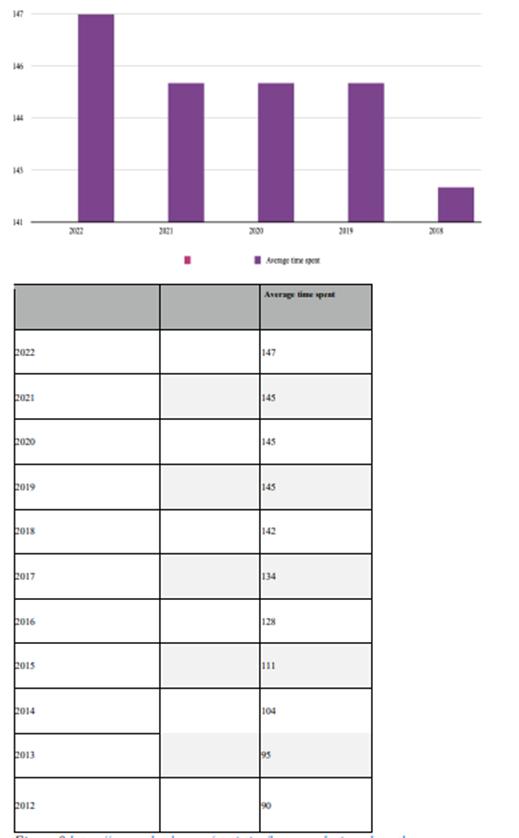
Holistic Marketing Management 31
the younger age. Men aged 30 to 39 make-up 12.1% of the total social media users worldwide, while women in this age group make-up 10.1%. The 40 to 49 age range is the third-largest in terms of age demographics for social media users worldwide, according to data research. They are 14.4% of the world's active social media members. Following this are users between the ages of 13 and 19, who makes the 13.1% of the total social networking subscribers, and people between the ages of 50 and 59, who make-up 9.8% of those who use social media. The age range of 60 and up has the least number of social media users who are active. Approximately 8.4% of all users worldwide are in this age bracket. According to this study on internet usage by age demographic groupings, people are less likely to be active online as they become older and enter the post-teenage years. Researchers believe that this may be because young individuals are using social networking sites as their main information source. In contrast, the older generation is more skeptical and favors to obtain its knowledge from reliable, conventional sources like television.
Figure 9. https://www.oberlo.com/statistics/what-age-group-uses-social-media-the-most
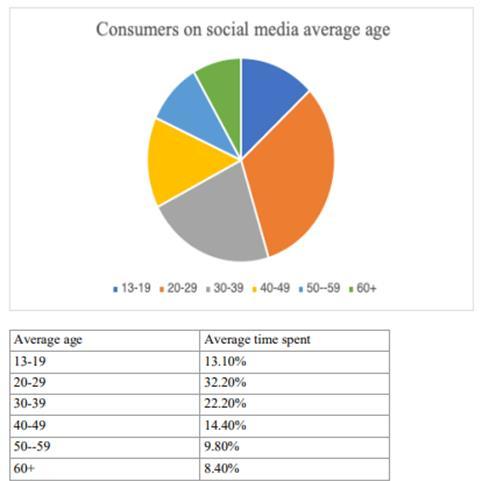
Holistic Marketing Management 32
Table 5 - Social Media’s Influence on Consumers’ Purchase Decisions (% of global respondents reporting influence)

From this graphic we can see how consumers on network platforms are easily affected by positive reviews that they read on social media.
Table 6- How many consumers shop online?
It’s only natural that as ecommerce grows, so will the number of online shoppers worldwide. As of 2023, the total number of digital buyers is 2.64 billion. This accounts for 33.3% of the global population. To put it another way, one out of every three persons you see is an online shopper. The number of customers has increased in recent years. In 2023, there will be 80 million more digital consumers than in 2022, representing a 3.1% year-over-year increase. Given the current trend, the opportunity for an ecommerce business is enormous. A more in-depth examination of all these ecommerce survey results would go a long way toward assisting aspiring ecommerce store owners in better understanding the orientation of online shopping.
Holistic Marketing Management 33
Figure 10 https://www.marketingcharts.com/charts/social-medias-influence-consumers-purchase-decisions
2.5 Main conclusions of the literature review
This study of the literature does a methodical critical analysis of the literature on consumer behavior on social media. The analysis discovered that contemporary marketers are effectively communicating with consumers about their products through traditional and social media channels. Given how much easier it has become to use social networking sites thanks to information and contemporary communication technologies, consumers are finding social media marketing to be more intriguing, inventive, and interactive. Additionally, customers' confidence in the knowledge they learn from these websites is rapidly growing. Although there isn't much of a trend toward buying, the individuals that do are happy with their purchases. Therefore, although there is still a way to go for marketers, using social networking sites for brand communication is steadily proving efficient. The following are the study’s main conclusions and recommendations for effective marketing tactics:
1. Since the majority of Internet users are aware of social media and use it themselves, marketers should shift their promotional efforts from traditional methods to social media tools and utilize a well-integrated social media strategy taking various platforms into account.
2. Customers have a favorable opinion of social media marketing strategies; they believe that social media advertising is more thorough, communicative, inventive, and reliable than traditional advertising.

Holistic Marketing Management 34
Figure 11. https://www.oberlo.com/statistics/how-many-people-shop-online
3. Social media not only raises brand awareness among consumers, but consumers also favor the products promoted there when making a final purchase. Nowadays, people buy things to appear “liked”. Therefore, a marketing strategy needs to be more all-encompassing, with educational and shareable material as well as a good consumer engagement policy that is followed to foster relationships
4. It can be mentioned that while advertising on social media websites, marketers may also receive more information about prospects, which can assist them to target customers in a better way. The respondents used in the study feel comfortable revealing their information on social media websites.
To sum up, social media marketing has become essential, one that is a blessing to the company due to the user impact and general presence of social networks. Due to this, social media marketing is no longer regarded as being on trial and has instead established itself as a crucial component of the commercial sector.
The qualitative research conducted in this paper on the impact of social media on consumer behavior is necessary to capture the intricacies and complexities of consumer experiences, understand the contextual influences, uncover underlying motivations and emotions, explore emerging phenomena, and complement qualitative research. This qualitative approach broadens our understanding of the subject and offers insightful information to researchers, firms, and marketers that are trying to understand and successfully use the impact of social media on customer behavior.
References
1. Another perspective on Guest Bunce and Johnson’s (2006) landmark study.
2. Association for Psychological Science, 2008. Complex Decision? Don’t Think About It. ScienceDaily. (http://www.sciencedaily.com/releases/2008/12/081209154941.htm [Retrieved May 25 2013]).
3. Bakker D. (2018) Conceptualising influencer marketing. Journal of emerging trends in marketing and management 1(1) pp.79–87.
4. Barefoot D. & Szabo J. (2010). “Friends With Benefits: A Social Media Marketing Handbook” San Francisco: No Starch Press.
5. Bruner, J. S., Goodnow, Jacqueline J., and Austin, G. A. (1956). A Study of Thinking. New York: John Wiley & Sons publications in psychology; Association for Psychological Science, 2008.
6. Chintan H Rajani and Dr. Ashvin Solanki Motivations For Using Social Media: An Exploratory Study. International Journal of Management 7(4) 2016, pp.123–129.
7. D. Lakshmanan and Dr. S. Rabiyathul Basariya, “The Role of Social Media On Enhancing Advertising Effectiveness”, International Journal of Civil Engineering and Technology 8(9) 2017, pp. 1042–1047.
8. Di Pietro Loredana, Eleonora Pantano (18-29, July/September 2012). “An empirical investigation of social network influence on consumer purchasing decision: The case of Facebook” Journal of Direct Data and Digital Marketing Practice, 14, 18-29
9. Drury G.N , 2008. “Social Media: Should marketers engage and how can it be done effectively”.
10. Edelman D.C. (2010) Branding in the digital age: You’re spending your money in all the wrong places, Harvard Business Review [Online]
Available: http://hbr.org/2010/12/branding-in-the-digital-age-youre-spending-your-money-in-all-the-wrong-places/ar/1 [15
11. Figure 1. Cox et al., 1983. The five-stage model, Planning, search, certainty and satisfaction among durables buyers: a
12. Longitudinal study. Advances in Consumer Research X:394-399.
13. Figure 2. Steps between evaluation of alternatives and a purchase decision Kotler P. & Keller K. L., 2009. Marketing management. Upper Saddle River, N.J: Pearson Prentice Hall.
Holistic Marketing Management 35
14. Figure 3. Social media components Dann S. & Dann. S., 2011. E-Marketing: Theory and Application. London U.K: Palgrave Macmillan.
15. Figure 5 Four types of buying behavior Clootrack 2020, https://www.clootrack.com/knowledge_base/types-of-consumer-behavior
16. Foley G., Timonen V. Using Grounded Theory Method to Capture and Analyze Health Care Experiences. Health Serv Res. 2015 Aug;50(4):1195-210. 17. Global Instagram influencer market size from 2017 to 2020. https: //www.statista.com/statistics/748630/globalinstagram-influencer-market-value
18. Hoyer W.D. & Macinnis D.J. (2008) “Consumer Behaviour”, 5th edition, Cengage Learning 19. http://www.marketingweek.co.uk/sectors/sport/nike-takes-social-media-in-house/4005240.article
20. https://www.clootrack.com/knowledge_base/types-of-consumer-behavior
21. Hudson S. (2008) “Tourism and Hospitality Marketing: A Global Perspective”, SAGE Publications
22. Jepsen A.L. (2007) ‘Factors affecting consumer use of the internet for information search’, Journal of Interactive Marketing, Vol. 21, No. 3, pp.21–34.
23. Joseph S. 2013. Nike Takes Social Media In-House.
24. Kacen. J. J. and Lee. J. A. (2002) “The influence of culture on consumer impulsive buying behaviour”, Journal of consumer psychology. 12(2) pp. 163-174.
25. Kotler P. & Keller K. L. (2015). Marketing management. Boston: Pearson. 26. Kotler P.; Wong V.; Saunder J.; Armstrong G., 2005 Principle of Marketing, 4th European edition. Pearson Education Inc.
27. Loudon D. L. & Della Bitta A. J. (1993). Consumer Behaviour: Concepts and Applications (4th ed.). New York: McGraw-Hill.
28. Maslow A. H. (1970). Motivation and Personality (2nd ed.). New York: Harper & Row.
29. Matter Communications 2020 Survey Methodology: Matter collected responses from 1000 U.S.-based consumers in May 2020 via a thirdparty provider to determine the findings of this survey.
30. Moser A Korstjens I. Series: Practical guidance to qualitative research. Part 1: Introduction. Eur J Gen Pract. 2017 Dec;23(1):271-273.
31. O’Reilly T. 2006. Web 2.0 Compact Definition: Trying Again. (http://radar.oreilly.com/2006/12/web-20-compact-definition-tryi.html
32. Ofir C. and Simonson I. (2005) “The Effect of Stating Expectations on Customer Satisfaction and Shopping Experience” Stanford Graduate School of Business 44p
33. Punj G. (2012) ‘Consumer decision making on the web: a theoretical analysis and research guidelines’, Psychology and Marketing, Vol. 29, No. 10, pp.791
803.
34. Sadia Afzal Javed, Rabbani Khan (2015) Impact of online and conventional advertisement on consumer buying behaviour of branded garments. Asian Journal of Management Sciences & Education
35. Silverman G., 2001. The Secrets of Word-of-Mouth Marketing. USA: AMACOM.
36. Smith Adam, 1776. An Inquiry into the Nature and Causes of the Wealth of Nations. London: Methuen & Co (Book IV chapter 8 49)
37. Soloman M.; Bamossy G. & Askegaard S., 2002. Consumer Behavior: A European Perspective. Upper Saddle River N.J: Pearson Prentice Hall.
38. Sternthal B. & Craig C. S., 1982. Consumer Behavior: An Information Processing Perspective. Englewood Cliffs N.J: Prentice Hall Inc.
39. Vinerean Simona, Iuliana Cetina, Luigi Dumitrescu, Mihai Tichindelean “The Effects of Social Media Marketing on Online Consumer Behavior”, International Journal of Business and Management; Vol. 8 No. 14; 2013
40. Weber L. 2009. Marketing to the Social Web: How digital customer communities build your business. Second Edition. N.J USA: John Wiley and Sons.
41. Weinberg T., 2009. The New Community Rules: Marketing on the Social Web. Sebastopol CA
42. Zarrella D., 2010. The Social Media Marketing Book. Sebastopol CA: O’Reilly Media Inc. [Original source: https://studycrumb.com/alphabetizer].
Holistic Marketing Management 36
–
E-Commerce, E-Fulfillment, Last Mile Delivery and CX
Drd. Ioan Matei PURCĂREA
Abstract
It’s the real time now for e-commerce business to better understand the role of e-fulfillment within the sociotechnical complexity, considering the sequential nature of the order process within omnichannel landscape. There is no doubt about the need to pay attention to the chain of circumstances of the many challenges confronted by the last mile delivery, identifying affordable delivery alternatives for SMEs. Last mile delivery remains a key differentiator in ensuring the success of integrated omnichannel retailing, improving CX.
Keywords: E-commerce, E-fulfillment, Last mile delivery, SMEs, CX

JEL Classification: D83; L81; L86; M15; M31; O32; O33
Better understanding the role of e-fulfillment within the sociotechnical complexity, considering the sequential nature of the order process within omnichannel landscape
According to Kernstock et al. (2023), as at the center of advances in the e-commerce domain (for instance, receiving live updates about the delivery process via the so-called push notifications) are now new developments in the Information Systems (IS) area, it is important to consider – beyond the pivotal construct in IS research – experience as a more encompassing construct complementing satisfaction, by including the entire challenging order process. Based on a comprehensive literature review, they showed, among other aspects, that possibly core to
Holistic Marketing Management 37
the functioning of e-commerce are both multiple touchpoints and IS acting together, and the understanding of contemporary IS (which can also take appropriate action with sociotechnical complexity, not only generate competitive advantage, as argued by Benbya et al., 2020) can be updated and extended by investigating the affective response to the e-commerce system (digital technology, purchasing process, delivery of goods and services), following the whole user experience assessment. Going beyond pure online processes, it is important to consider the sequential nature of the order process within omnichannel environment (as argued by Bijmolt et al., 2021), connecting this way the customer journey to the product flow, as shown in figure below.
Figure no. 1: Connecting the omni-channel customer journey to the product flow: Key decision areas at the marketing-operations interface Panel (a) depicts the omni channel customer journey: consumers migrate between channels throughout their journey, between and within stages. Panel (c) depicts the firm’s product flow. The two panels are interconnected through firm decisions that affect both journey (panel (a)) and product flow (panel (c)). These decisions, indicated in panel (b), are located at the marketing-operations interface. The red bidirectional arrows indicate how the decisions interact with the customer journey on the one hand (between panel (a) and (b)) and with the product flow on the other (between panel (b) and (c)). The dotted-dash lines in panel (a) indicate that multiple paths are possible.

Source: Bijmolt, T. H. A., Broekhuis, M., Leeuw, S. d., Hirche, C., Rooderkerk, R. P., Sousa, R., & Zhu, S. X., 2021. Challenges at the marketing–operations interface in omni-channel retail environments. Journal of Business Research, Volume 122, January 2021, p. 866 (Work cited)
Coming back to Kernstock et al., it is useful to show that they underlined the lack of: clear consensus with regard to the conceptualization of the constructs of the order process (see figure below), while appearing multiple times the themes with regard to the operationalization of
Holistic Marketing Management 38
these constructs, satisfaction, outcome, and their relationship; consensus regarding the most important elements from a customer perspective; knowledge on the most important order process aspects for consumer reactions.
Source: Kernstock, P., Przybilla, L., Thatcher, J.B., Krcmar, H., 2023. “Can't Get No Satisfaction?" – The Case for Broadening Information Systems Research on E-Commerce. [pdf] Proceedings of the 56th Hawaii International Conference on System Sciences, p. 3800 (Work cited)
As shown by Titiyal et al. (2023), there is a real need today to better understand the role of e-fulfillment (defined as a sequence of processes, such as: customization strategies, website quality, distribution strategies, last mile delivery and return management) within the rapid increase in e-tailing (web retailing). The authors synthesized from the literature both efulfillment definitions and resulted components, as shown in the below table, underlining that efulfillment (as logistics-related activity) differs from the product’s traditional delivery (Melacini et al., 2018), consisting of e-tailer website, order procurement and product return processes as shown by Jain et al. (2015) in figure below.

Holistic Marketing Management 39
Figure no. 2: Overview of order process concepts
Source: Adapted from Titiyal, R., Bhattacharya, S., J. Thakkar, J.J. and Sah, B., 2023. Impact of efulfillment on consumer loyalty across different product types, Journal of Asia Business Studies, Vol. 17 No. 2, 2023, p. 443 (Work cited)
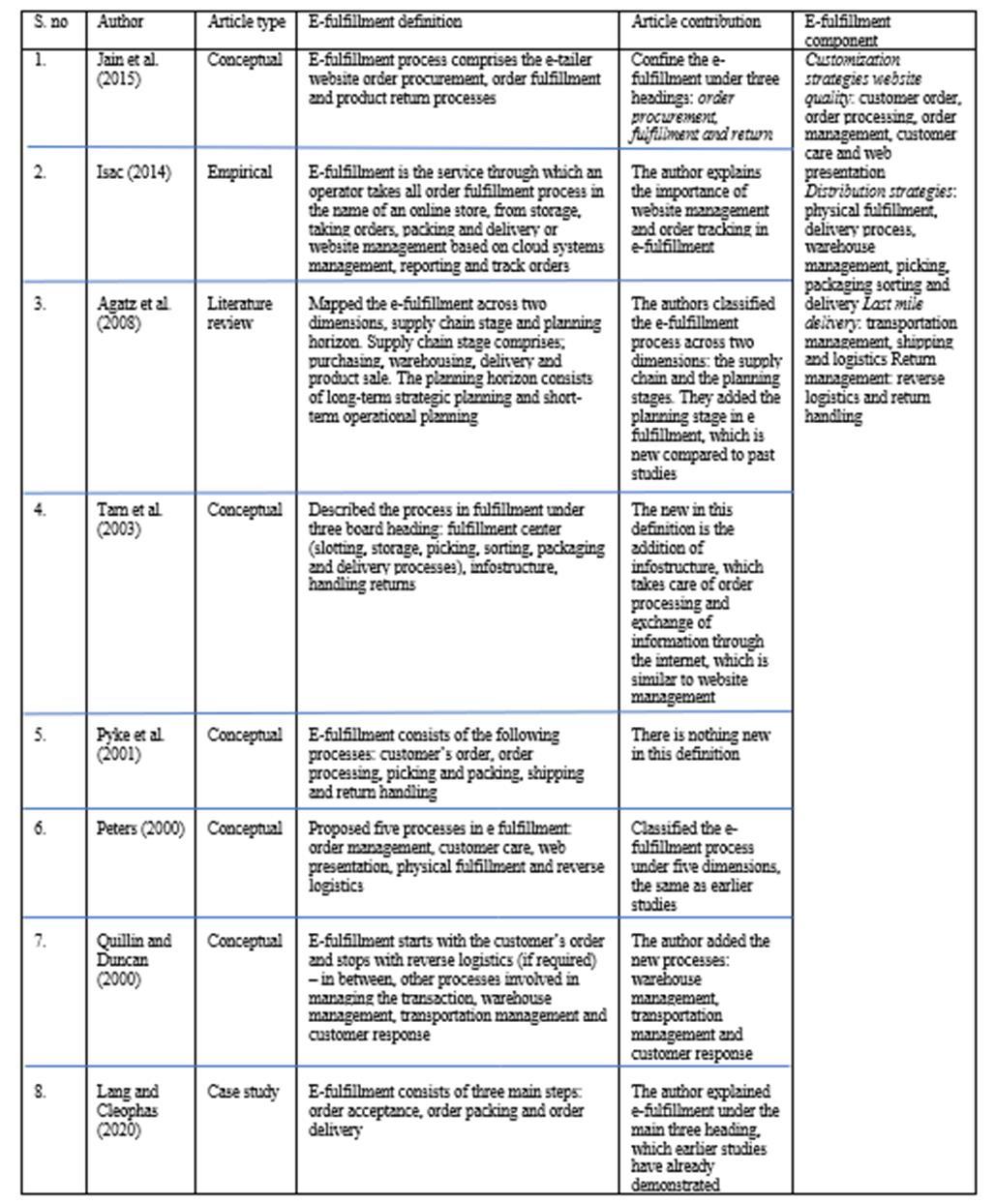
Holistic Marketing Management 40
Table no. 1: E-fulfillment definitions and resulted components
Source: Titiyal, R., Bhattacharya, S., J. Thakkar, J.J. and Sah, B., 2022. Impact of e-fulfillment on consumer loyalty across different product types, Journal of Asia Business Studies, Vol. 17 No. 2, 2023, p. 441 (Work cited)
According to Lang, Cleophas & Ehmke (2021), there is a direct linkage between the apparently unstoppable growth of e-commerce and the so-called attended home deliveries (AHD), which requires offering narrow delivery time slots for online booking (customers’ orders being finalized by choosing from these slots). These time slots are seen as both a driver, and a result of the increasing e-commerce (a shopping basket being filled by customers who provide their delivery address on the e-commerce retailer’s website). The authors showed how profitability can be maintained by planners helped by dynamic slotting decisions (the set of time slots offered to individual customers being limited), these decisions depending not only to on the current customers’ request and the already accepted customers’ orders, but also on the customers’ orders still expected to arrive On the other hand, as shown by Escudero-Santana et al. (2022), the logistical operators’ economic benefits are depending on costs’ reduction without affecting customers’ perceived level of service whose quality is increased by customers’ possibility to choose a preferred time slot for the delivery.
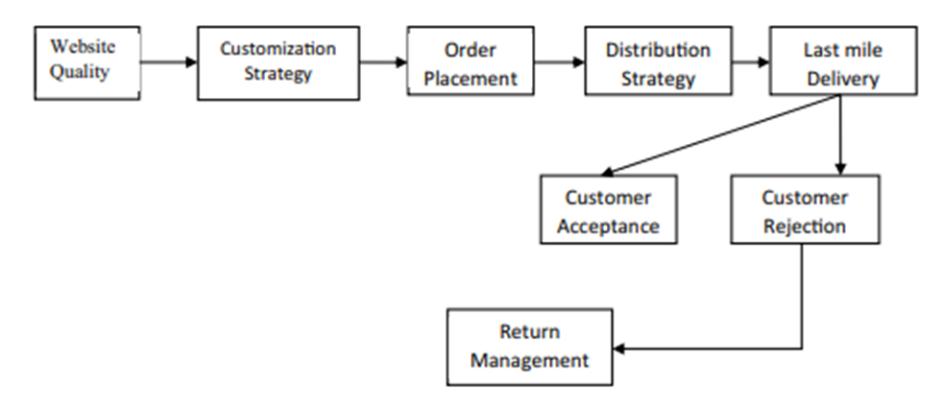
Paying attention to the chain of circumstances of the many challenges confronted by the last mile delivery, and identifying affordable delivery alternatives for SMEs
As shown in the analysis made by Ha, Akbari and Au (2023), there is no doubt about the need for a more complete and balanced definition of last mile delivery, and they choose to adopt the definition given by Motavallian (2019, p. 106): “The last transportation of a consignment in a supply chain from the last dispatch point to the delivery point where the consignee receives the consignment.” The authors explained on this basis that there does not exist a fixed and definitive last mile delivery structure (many such kind structures can be generated depending on order preparation point, last dispatch point, and delivery point), and presented a general and simplified structure of the last mile delivery, as shown in the first figure below. Among other aspects, they also brought to our attention how costly is the last mile challenge, as highlighted in the relevant literature, taking into account that: the most inefficient and costly activity of the supply chain is
Holistic Marketing Management 41
Figure no. 3: E-fulfillment process (according to Jain et al., 2015)
the last mile delivery (according to Boysen et al., 2020); there is also a routine in benefitting of free delivery and short lead-times, meaning reduced margin on delivery (according to Deloitte, 2020). And in order to exemplify both causes and effects of the many challenges faced by the last mile delivery the authors presented an Ishikawa Diagram, also known as Fishbone Diagram (see the next figure below).

Source: Ha, N.T.; Akbari, M.; Au B., 2023. Last mile delivery in logistics and supply chain management: a bibliometric analysis and future directions, Benchmarking: An International Journal, 30(4) – Adapted from: Castillo and Jain, 2019; Motavallian, 2019 (Work cited)
Source: Ha, N.T.; Akbari, M.; Au B., 2023. Last mile delivery in logistics and supply chain management: a bibliometric analysis and future directions, Benchmarking: An International Journal, 30(4) – “Adapted from Aljohani, K and Thompson, R G.,2020” as “Adapted from Aljohani et al., 2020” (Work cited)
Risberg, Jafari and Sandberg (2023) made a rigorous fuzzy-set qualitative comparative analysis on omnichannel retailers, and provided further practical and theoretical relevance,

Holistic Marketing Management 42
Figure no. 4: Last mile delivery structure
Figure no. 5: Fishbone diagram of the costly last mile delivery
demonstrating that fulfilment (in which the final part of the order fulfillment process, last mile delivery, is seen as comprising “activities and processes involved in serving consumers by handing over the ordered parcels at their location of choice”) and returns (considering how complex and costly is to right manage omnichannel last mile returns flows) should be concomitantly considered when approaching the wide range of delivery options. They pledged for taking into account more meticulously the interaction between the approaches to last mile logistics and firms’ characteristics (online-oriented SMEs, store-oriented SMEs, large storeoriented retailers and large online-oriented retailers) associated with firms’ performance within the context in which retail industry is challenged in a noticeable way on the path to digital transformation. The authors resorted to a very suggestive conceptual model (see figure below), and concluded that depending on the firm characteristics could be planned in detail specific performant solutions (less-costly delivery alternatives for SMEs) by utilizing stores and warehouses for online order fulfilment (SMEs being focused on simplicity) and returns

Source: Risberg, A., Jafari, H. and Sandberg, E., 2023. A configurational approach to last mile logistics practices and omni-channel firm characteristics for competitive advantage: a fuzzy-set qualitative comparative analysis. [pdf] International Journal of Physical Distribution & Logistics Management (IJPDLM), Vol. 53 No. 11, 2023, p. 560 (Work cited)
Instead of conclusions: Last mile delivery remains a key differentiator in ensuring the success of integrated omnichannel
retailing, improving CX
There is no doubt about the challenging future of the last-mile delivery Some time ago we made reference at:
- Different delivery networks for last-mile delivery (see figure below), within a very suggestive context: of the emerging challenges for the ecosystem, considering the immense economic benefits for the private sector offered by e-commerce growth, the instant and time-definite
Holistic Marketing Management 43
Figure no. 6: Conceptual model with parameters
delivery allowed in the delivery segments by the technological advancements, and the new normal described by the faster delivery (WEF, 2020);

Source: World Economic Forum, 2020. The Future of the Last-Mile Ecosystem. [pdf] Transition Roadmaps for Public- and Private-Sector Players, January 2020, p. 11 (Work cited)
- Last-mile delivery evolution until 2030, from autonomous delivery systems, en-route manufacturing, robotic stores on wheels, delivery lockers… to digital twins, as shown in figure below (CB Insights, 2022).
Source: World Economic Forum, 2020. The Future of the Last-Mile Ecosystem. [pdf] Transition Roadmaps for Public- and Private-Sector Players, January 2020, p. 11 (Work cited)

Holistic Marketing Management 44
Figure no. 7: Seven different delivery networks for last-mile delivery
Figure no. 8: Future of last-mile delivery
We started from highlighting the importance of experience as a more encompassing construct complementing satisfaction (within the order process). Going back in time, allow us to remember how clear was that last-mile delivery is considered key to the customer experience (CX), as well as “the most expensive and time-consuming part of the entire supply chain”, being necessary “to lower the delivery cost of each order while also showing up on time consistently and keeping your customers happy”, where the pressure for the last-mile delivery optimization (Route4Me, 2021).
Allow us to end by offering a suggestive quotation to inspire new research: “The CX journey is one littered with varied and contrasting viewpoints, a multiplicity of concurrent experiences and a clash of competing and contrasting values. How a practitioner can creatively help the customer navigate this multi-vocal consumption landscape, plant and position a set of pre-emptive touchpoints to address and respond to the three types of modular concerns, determines whether an offering can ultimately succeed or fail in the marketplace” (Zha, Marvi and Foroudi, 2023).
References
Agatz, N.A., Fleischmann, M. and Van Nunen, J.A., 2008. E-fulfilment and multi-channel distribution – a review, European Journal of Operational Research, Vol. 187, issue 2, pp. 339-356.
Aljohani, K. and Thompson, R.G., 2020. An examination of last mile delivery practices of freight carriers servicing business receivers in inner-city areas, Sustainability, Vol. 12, No. 7, 2837. Doi: 10.3390/su12072837.
Aljohani, K. and Thompson, R.G., 2020. Receivers-led delivery consolidation policy: estimating the characteristics of the most interested businesses to participate, Research in Transportation Economics, Vol. 80, 100808. Doi: 10.1016/j.retrec.2019.100808.
Benbya, H., Nan, N., Tanriverdi, H., & Yoo, Y., 2020. Complexity and information systems research in the emerging digital world. MIS Quarterly, Vol. 44, No. 1, pp. 1-17/March 2020. DOI: 10.25300/MISQ/2020/13304.
Bijmolt, T. H. A., Broekhuis, M., Leeuw, S. d., Hirche, C., Rooderkerk, R. P., Sousa, R., & Zhu, S. X., 2021. Challenges at the marketing–operations interface in omni-channel retail environments. Journal of Business Research, Volume 122, January 2021, pp. 864-874. https://doi.org/10.1016/j.jbusres.2019.11.034.
Boysen, N., Fedtkey, S. and Schwerdfeger, S., 2020. Last mile delivery concepts: a survey from an operational research perspective, OR Spectrum, pp. 1-58. doi: 10.1007/s00291-020-00607-8.
Castillo, C. and Jain, A., 2019. Delivering on the “Last Mile” - A Shift from the Traditional Supply Chain, industry report. [pdf] Wipro. Available at: <https://www.wipro.com/content/dam/nexus/en/service-lines/consulting/latest-thinking/delivering-on-thelastmile-A-shift-from-the-traditional supply-chain.pdf>.
CB Insights, 2022. The Future of Last-Mile Delivery: How technology is tackling the complexity and cost of fulfillment, October 3, 2022. Available at: <https://www.cbinsights.com/research/report/future-of-last-mile-delivery/?>.
Deloitte, 2020. The Last Mile Challenge in Canada It’s Time to Jumpstart the Evolution of the Delivery Ecosystem, industry report, Deloitte. Available at: <https://www2.deloitte.com/content/dam/>.
Escudero-Santana, A.; Muñuzuri, J.; Lorenzo-Espejo, A.; Muñoz-Díaz, M.-L., 2022. Improving E-Commerce Distribution through Last-Mile Logistics with Multiple Possibilities of Deliveries Based on Time and Location. J. Theor. Appl. Electron. Commer. Res. 2022, 17, pp. 507–521. https://doi.org/10.3390/ jtaer17020027.
Holistic Marketing Management 45
Ha, N.T.; Akbari, M.; Au B., 2023. Last mile delivery in logistics and supply chain management: a bibliometric analysis and future directions, Benchmarking: An International Journal, 30(4), pp. 1137-1170. https://doi.org/10.1108/BIJ-07-2021-0409.
Isac, C., 2014. E-fulfilment-a new challenge for electronic business, Annals of the University of Petrosani, Economics, Vol. 14, No. 1, pp. 121-128.
Jain, N.K., Gajjar, H., Shah, B.J. and Sadh, A., 2015. A conceptual framework for measuring e-fulfilment dimensions: a consumer perspective, Journal of Internet Commerce, Vol. 14, No. 3, pp. 363-383.
Kernstock, P., Przybilla, L., Thatcher, J.B., Krcmar, H., 2023. “Can't Get No Satisfaction?" – The Case for Broadening Information Systems Research on E-Commerce. [pdf] Proceedings of the 56th Hawaii International Conference on System Sciences, pp. 3797-3806. Available at: <https://scholarspace.manoa.hawaii.edu/server/api/core/bitstreams/8fb902fd-7dbb-473faf47-9fb15f5551d6/content> [Accessed 26 August 2023].
Lang, M. and Cleophas, C., 2020. Establishing an extendable benchmarking framework for e-fulfillment, Proceedings of the 53rd HI International Conference on System Sciences, HICSS 2020, Maui, Hawai’i, USA, January 7-10, 2020. ScholarSpace 2020, University of Hawaiʻi at Mānoa community.
Lang, M.A.K., Cleophas, C. & Ehmke, J.F., 2021. Anticipative Dynamic Slotting for Attended Home Deliveries. Oper. Res. Forum 2, 70 (2021), pp. 1-39. https://doi.org/10.1007/s43069-021-00086-9.
Melacini, M., Perotti, S., Rasini, M. and Tappia, E., 2018. E-fulfilment and distribution in Omni-channel retailing: a systematic literature review, International Journal of Physical Distribution & Logistics Management, Vol. 48, No. 4, pp. 391-414.
Motavallian, J., 2019. Last Mile Delivery in the Retail Sector in an Urban Context, PhD thesis, RMIT University, Melbourne. Available at: <https://core.ac.uk/download/pdf/237115181.pdf>.
Peters, J.E., 2000. Meeting the e-fulfilment challenge, Supply Chain Management Review, Vol. 5, pp. 64-70.
Pyke, D.F., Johnson, M.E. and Desmond, P., 2001. E-fulfilment, Supply Chain Management Review, Vol. 27 No. 5, pp. 50-62.
Quillin, T.J. and Duncan, M, 2000. Fulfilment: The industry behind the button, Industry Report, August, Stephens Inc.
Risberg, A., Jafari, H. and Sandberg, E., 2023. A configurational approach to last mile logistics practices and omni-channel firm characteristics for competitive advantage: a fuzzy-set qualitative comparative analysis. [pdf] International Journal of Physical Distribution & Logistics Management (IJPDLM), Vol. 53, No. 11, 2023, pp. 53-70. DOI 10.1108/IJPDLM-04-2022-0123.
Route4Me, 2021. 5 Last Mile Delivery Optimization Methods That Really Work, Route Optimization Blog - Route4Me, September 17, 2021. Available at: <https://blog.route4me.com/5-last-mile-delivery-optimization-methods/>.
Tarn, J.M., Razi, M.A., Wen, H.J. and Perez, A.A. Jr., 2003. E-fulfilment: the strategy and operational requirements, Logistics Information Management, Vol. 16, No. 5, pp. 350-362. DOI 10.1108/09576050310499345.
Titiyal, R., Bhattacharya, S., J. Thakkar, J.J. and Sah, B., 2022. Impact of e-fulfillment on consumer loyalty across different product types, Journal of Asia Business Studies, Vol. 17 No. 2, 2023, pp. 439-461. DOI 10.1108/JABS-10-2021-0410.
World Economic Forum, 2020. The Future of the Last-Mile Ecosystem. [pdf] Transition Roadmaps for Public- and PrivateSector Players, January 2020, pp. 1-26. Available at: <WEF_Future_of_the_last_mile_ecosystem>.
Zha, D., Marvi, R., Foroudi, P., 2023. Synthesizing the customer experience concept: A multimodularity approach, Journal of Business Research, Volume 167, November 2023, p. 23. https://doi.org/10.1016/j.jbusres.2023.114185.
Holistic Marketing Management 46
Congratulatory letter from Professor Peter Štarchoň on the occasion of the 30th Romanian-American University Anniversary
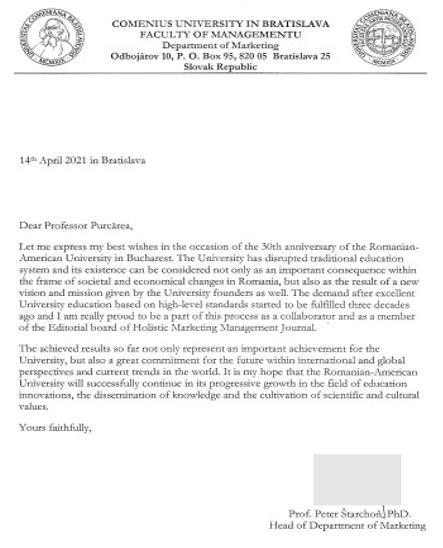
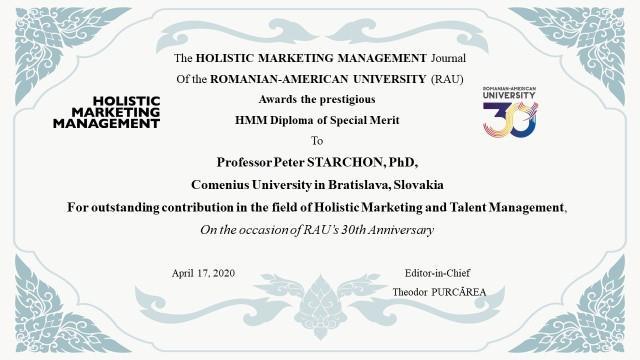

Holistic Marketing Management 47
‘Marketing Science and Inspirations’: Making Decisions Based on Social Media Metrics

Tracked by Marketers
Dr. Dan SMEDESCU
Associate Editor of the “Holistic Marketing Management” Journal
Member of the scientific association Romanian Distribution Committee

JEL Classification: Y30
The “Marketing Science and Inspirations” Journal is continuing to confirm its valued vocation of giving its savvy, affluent and implied readers a holistic perspective on modern marketing issues. A well-known brand of the Comenius University in Bratislava, Slovakia, the “Marketing Science and Inspirations” Journal firmly stands on the path of generating awareness and building lasting connections with its target audience, improving customer experience by identifying new ways to overcome marketing challenges. Using those considerations, we are witnessing our partners’ hard and smart work to provide to both current and new readers truly relevant and useful content on current business situations and key challenges faced by agile marketers, making marketing perspective happen.
Holistic Marketing Management 48
We were happy to receive by post the new Issue 2, Volume XVIII, 2023, of our Partner Journal “Marketing Science and Inspirations” , Comenius University in Bratislava, Slovakia.
The new challenging issue of this valuable academic journal (addressing to academics and practitioners) covered again, a wide range of interesting topics in the marketing research field, such as:
• “Brand Seduction as a tool for brand's success: Conceptualizing the term ”
The author Matouš Haicl focused on brand seduction (usable in marketing research) as a crucial element in achieving marketing success, the seduction concept being conceptualized by qualitative coding techniques, and consequently resulting three identified dimensions (interaction, irrationality, and ireality) of seduction. The concept of seduction was empirically tested thereafter through qualitative research methods, by interviewing key stakeholders experiencing brand seduction in order to verify the suitability of the theoretical concept. Research findings revealed the correspondence between the concept of brand seduction and these key stakeholders’ experience.
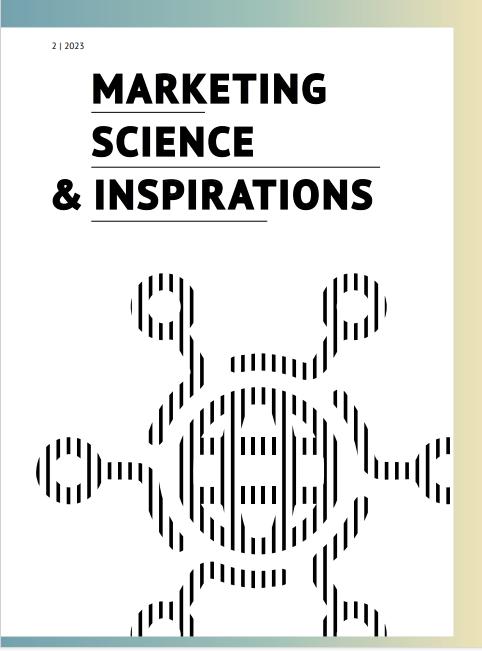
Holistic Marketing Management 49
• “Sustainable tourism development: Insights from accommodation facilities in Bukhara along the silk road.”
As due to the pandemic, economic and political circumstances substantial challenges were encountered by the tourism industry in the last few years, the authors Mukhriddin Kilichov and František Olšavský showed how the resilience of this industry can be enhanced by sustainable development frameworks, generating social, economic, and environmental advantages for people living in tourism destination as places of interest for tourists’ visit. To achieve this tourism destination needs to be developed under a familiar and effective brand based on both marketing strategic plans of action for achieving this specific goal, and promoted stakeholder collaboration. The authors surveyed near 200 accommodation facilities in a prominent Central Asian tourism destination and a significant component of the Silk Road legacy, Bukhara, Uzbekistan. They investigated these accommodation facilities’ perceptions of the Silk Road brand, local involvement in sustainable development initiatives, collaboration with the public sector, and the status of their service offerings. An on this research basis were made specific recommendations
• “Marketing strategies in response to tough times – lessons from India during a global crisis ”
After the authors Meenakshi Handa and Ronika Bhalla identified and categorized the various guidelines recommended in the existent literature on adapting marketing strategies to handle the challenges posed by economic and other sustained environmental crises across markets, these organized into themes strategies and initiatives served as a background to examine marketers’ marketing strategies and innovations used in India in order to cope with the disruptions caused by the COVID-19 pandemic. Research learnings allowed making recommendations for organizations confronted with the challenging times, confirming the contribution brought to the existent literature, and underscoring the importance of marketing strategies in managing crises, protecting brand value and market positioning while improving customer relationship. By adopting a broad perspective in analyzing marketing strategies, the study identified marketing tactics to be applied by a wide range of industries such as hospitality, tourism, fast-moving consumer durables, e-commerce etc.
• “The role of marketing metrics in social media: A comprehensive analysis ”
As social media has emerged as a powerful marketing tool, and revolutionized businesses’ interaction with consumers in the digital era, the authors Lucia Kočišová and Peter Štarchoň demonstrated how critical is for marketers within the continuous social media platforms’ evolution to effectively measure and analyze their efforts. The authors deeply explored marketing metrics’ significance in the area of interest of social media, highlighting the key metrics used to evaluate marketing campaigns and their impact on business success, and provided actionable insights into optimizing social media strategies for enhanced customer engagement and brand awareness, as well as for improved return on investment. Based on a
Holistic Marketing Management 50
comprehensive review of existing literature, industry reports, case studies, and expert opinions on marketing metrics in social media, the authors brought a significant contribution to marketers’ improved equipment with the necessary knowledge and tools to achieve meaningful results based on data-driven decisions, optimizing their social media strategies
The new issue of the “Marketing Science and Inspirations” Journal also included other sections such as:
▪ “Marketing Briefs” : Pavel Štrach –“Developing meaningful sales leads in the online environment”;
▪ “Short Communications”:
• “Marketer of the year contest 2022 has its winner”;
• Milan Banyár: “The academic and advertising community mourns – Pavel Horňák, the nestor and legend of Czechoslovak advertising, has left us”;
• František Olšavský: “Bernd Hallier, the distinguished marketing and business personality, has left us”
▪ “REVIEW”, Magdaléna Samuhelová, “Dhawan, Erica: Digital body language. Improve your communication in the online world. ”
▪ “DICTIONARY OF USEFUL MARKETING TERMS” , Dagmar Weberová
It is well-known that on the occasion of celebrating the 30th Anniversary of the Romanian-American University (RAU), “Holistic Marketing Management” Journal (HMM) was awarding an HMM Diploma of Special Merit to Professor Peter Štarchoň, for outstanding contribution in the field of Holistic Marketing and Talent Management.
And we always remember with pleasure that the Editor-in-Chief of the “Marketing Science and Inspirations” Journal – Professor Peter Štarchoň, Faculty of Management, Comenius University in Bratislava, Slovakia – is also a Member of the Editorial Board of both the “Holistic Marketing Management” Journal, and of the “Romanian Distribution Committee Magazine”.
Holistic Marketing Management 51
It is again our honor and pleasure to remember the significant meeting in Koln, Germany, in 2011, on the occasion of the working meeting of the European Retail Academy (ERA) We will all miss (https://www.crd-aida.ro/2023/06/the-distinguished-professor-bernd-hallier-passedaway/) our Great Friend Prof. Dr. Bernd Hallier. In the below image (in the upper right part) you can see a memorable moment with Prof. Dr. Bernd Hallier together with RAU Chief Administrative Officer Dumitru Smedescu (who was an important support for the RAU
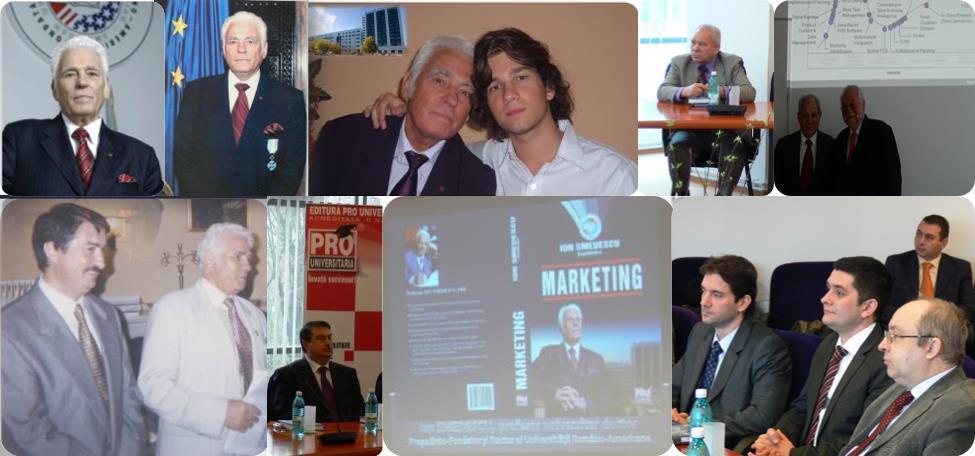
Founding Rector: https://www.rau.ro/in-memoriam-dlui-dumitru-smedescu-director-generaladministrativ/). Unfortunately, they both left us this summer.

Holistic Marketing Management 52
























































